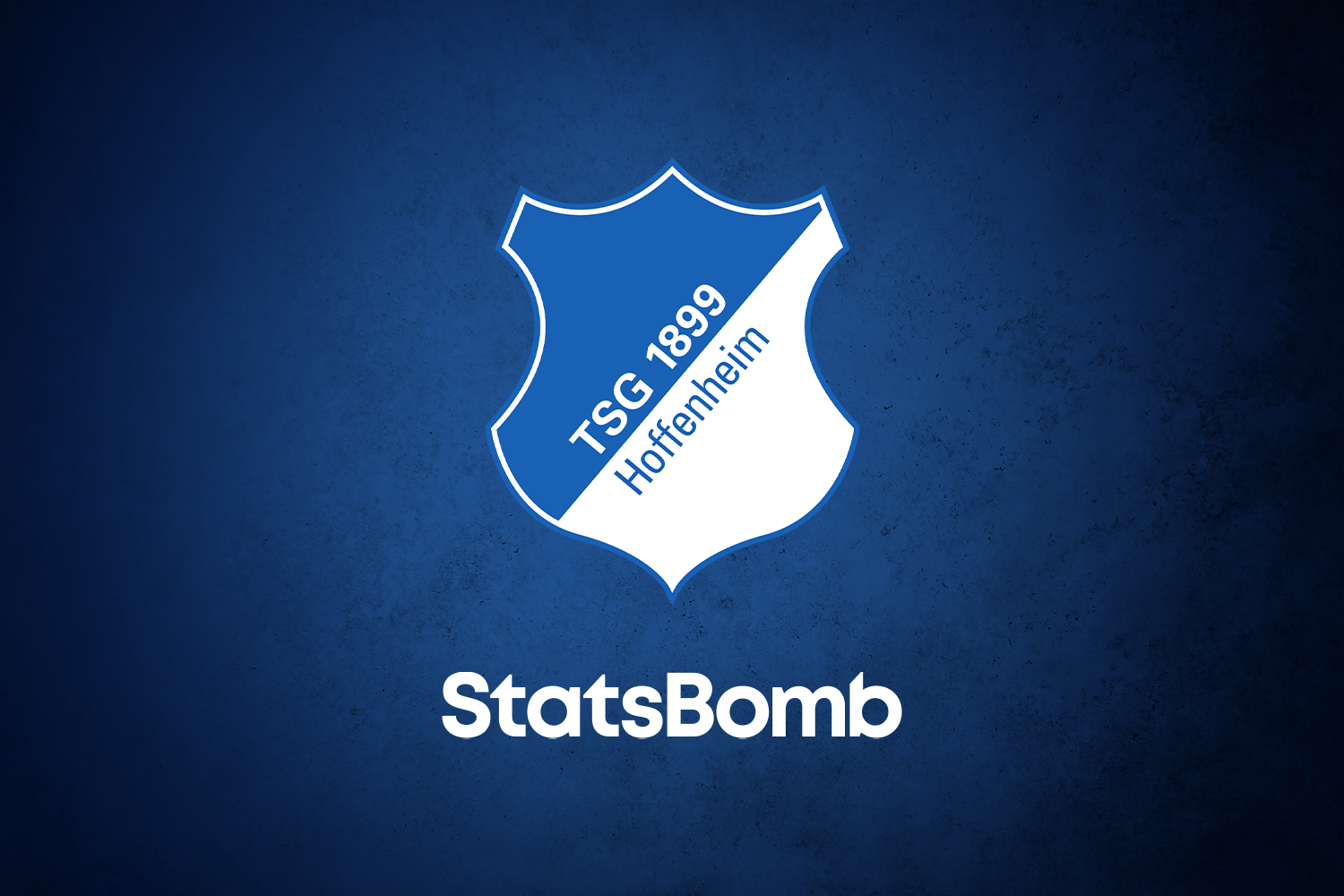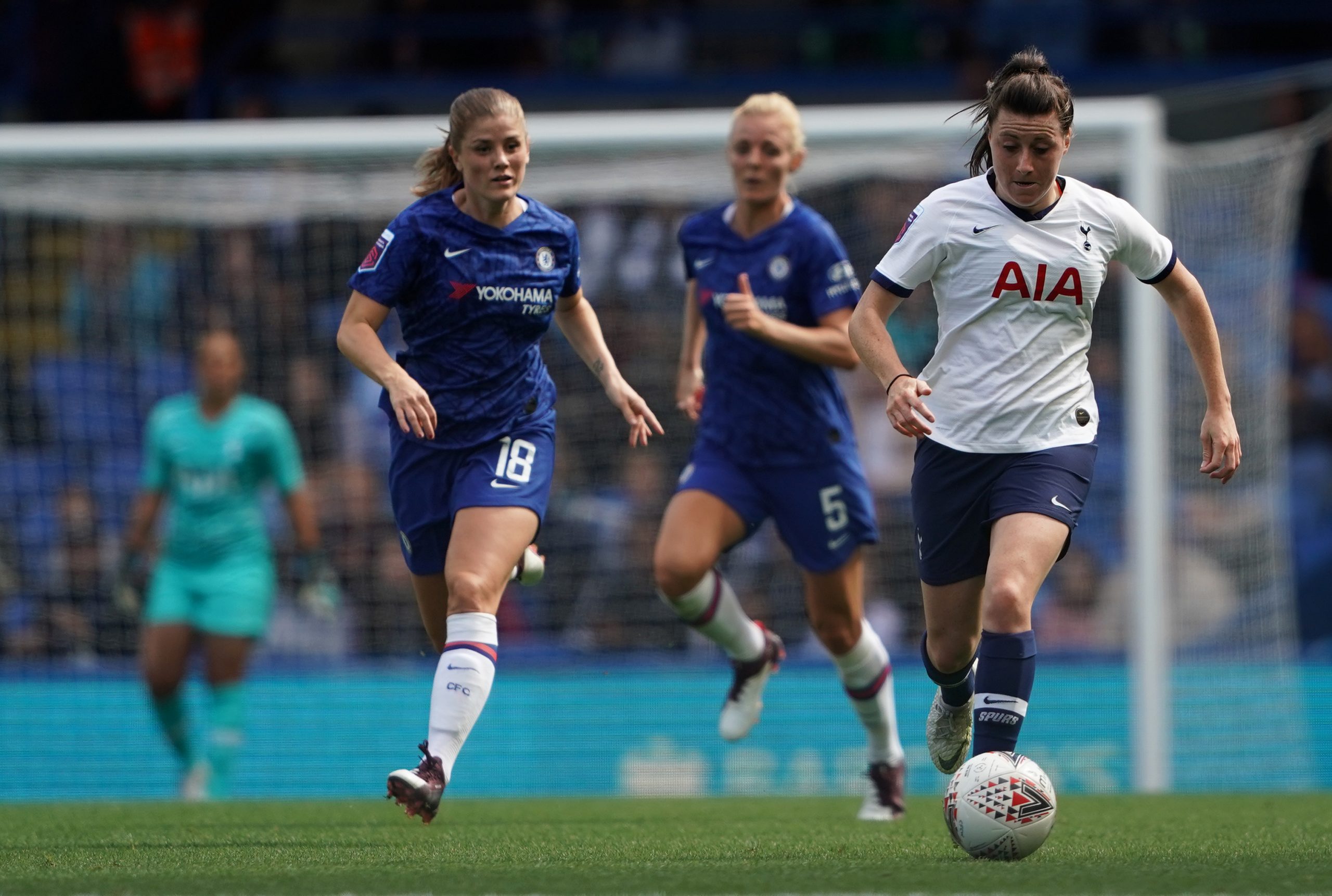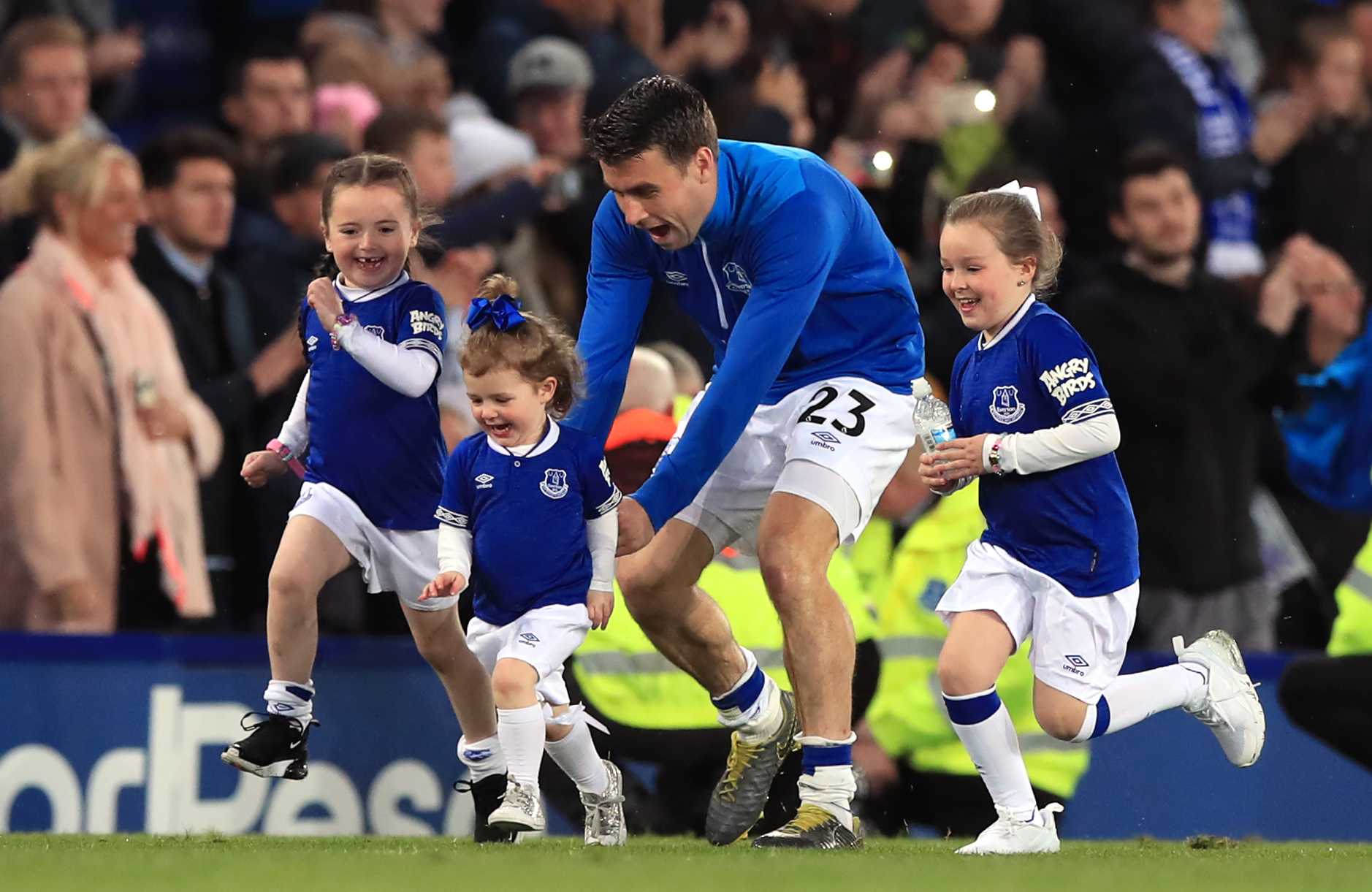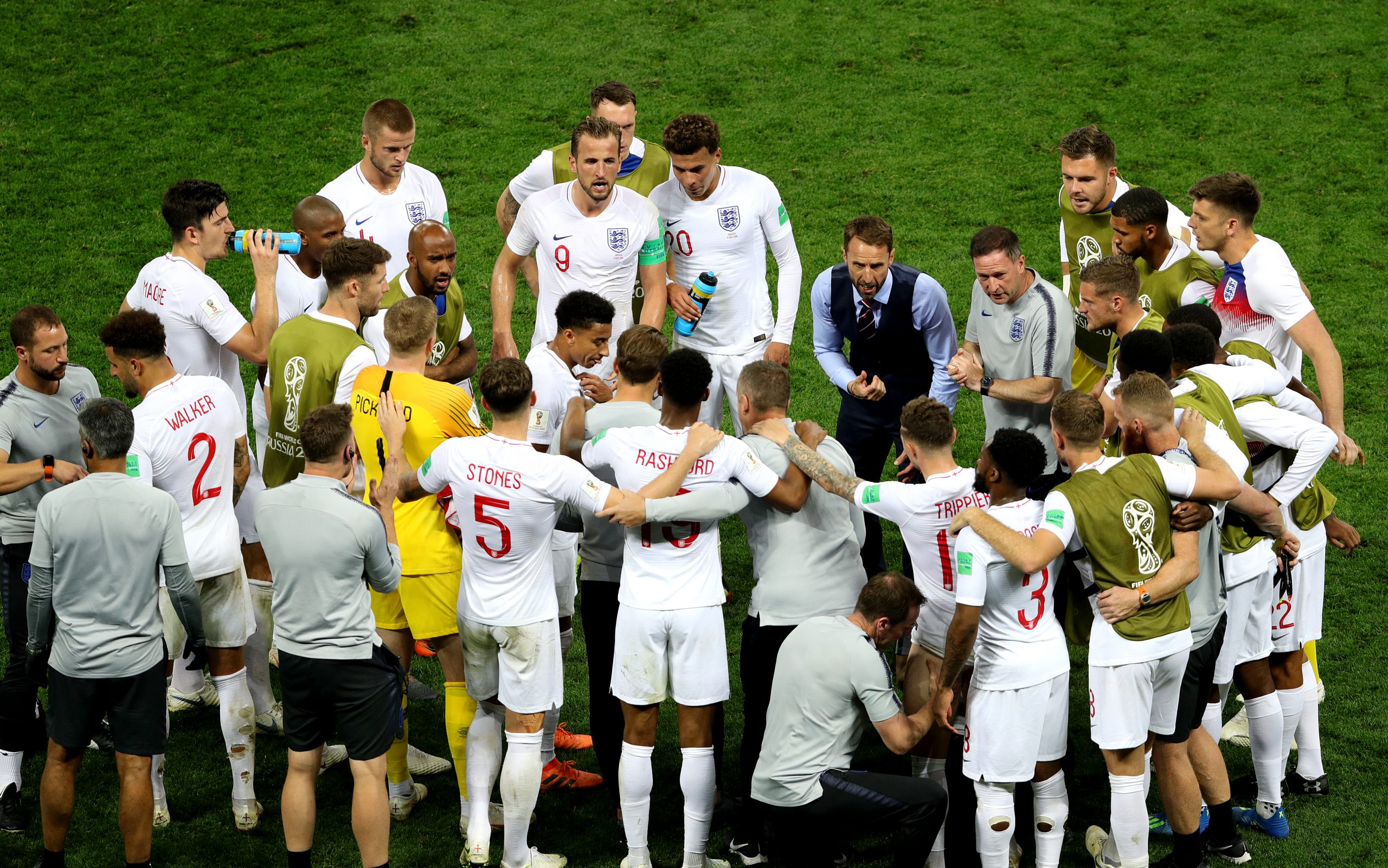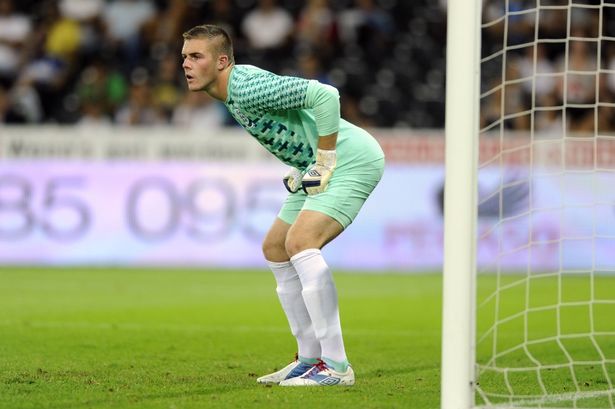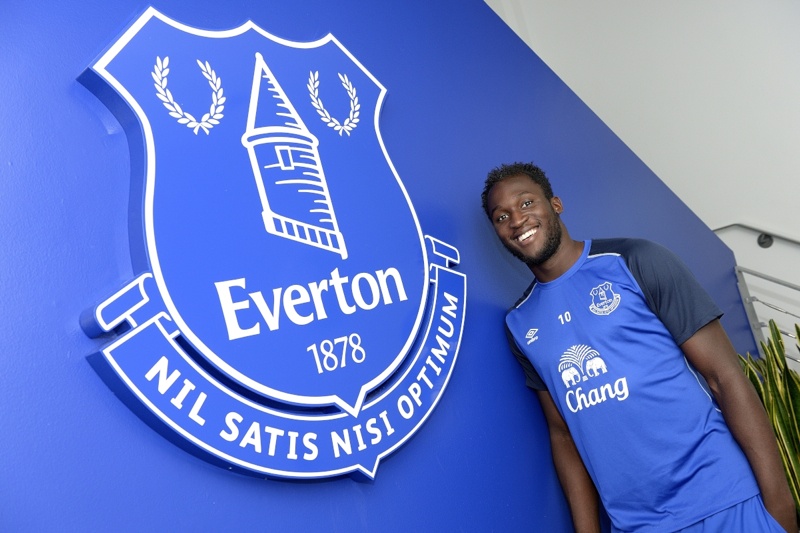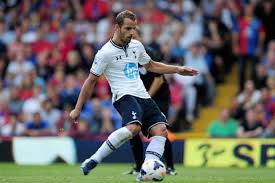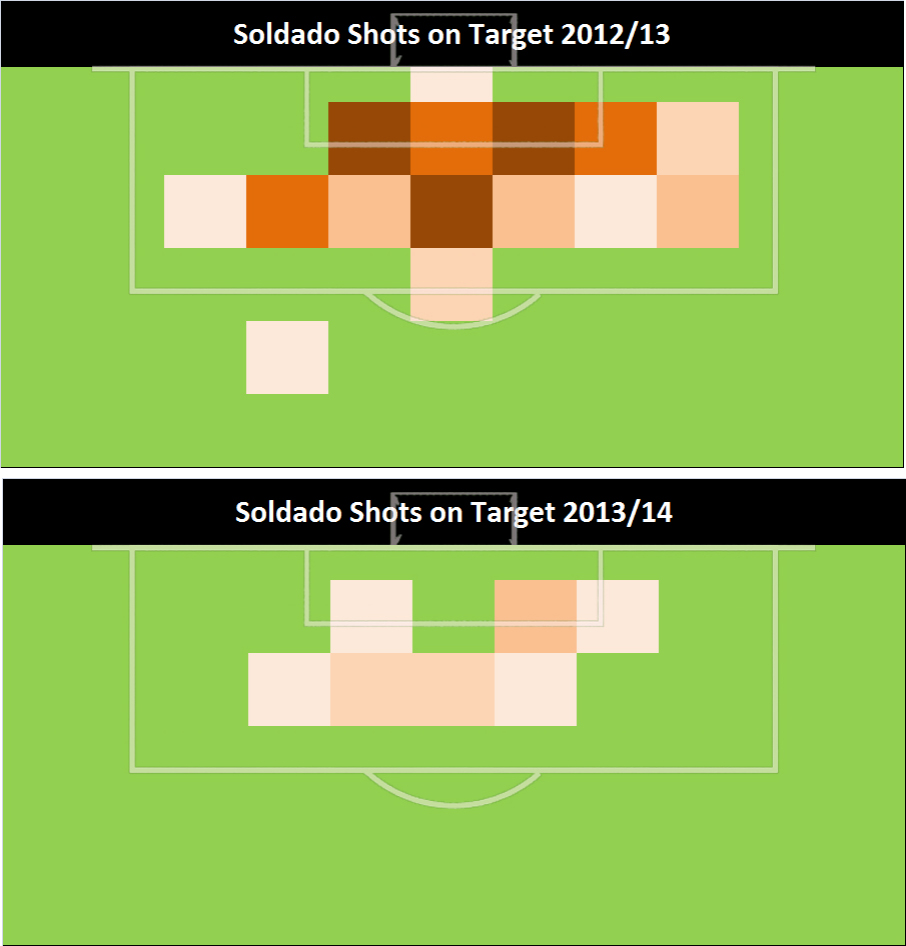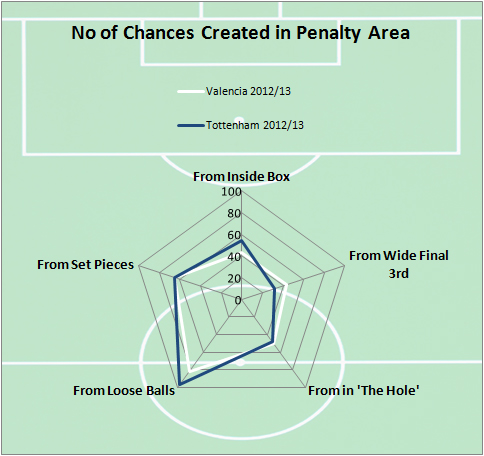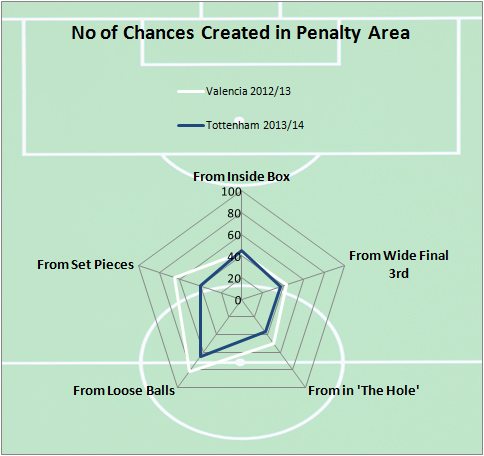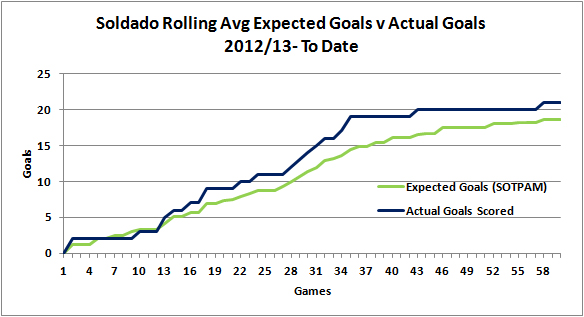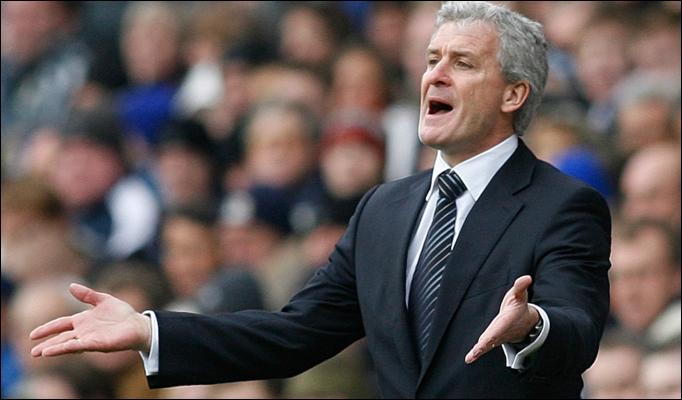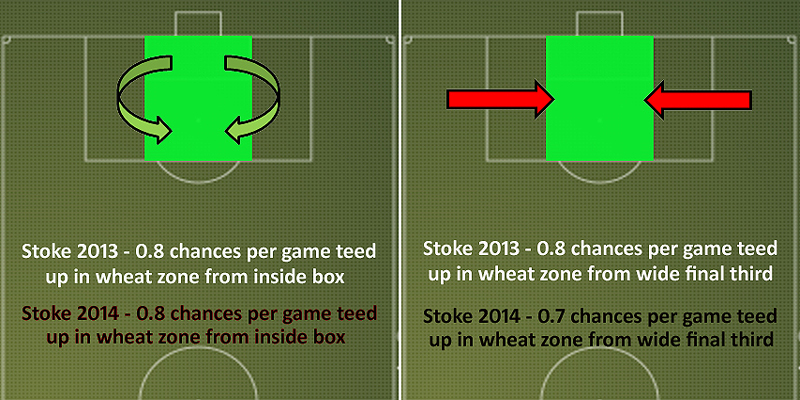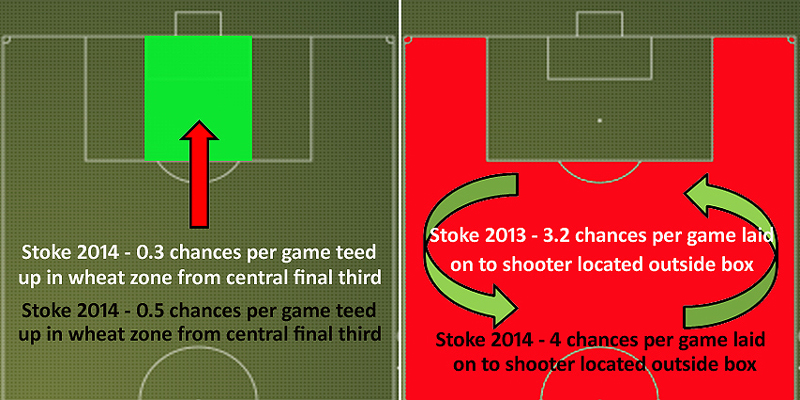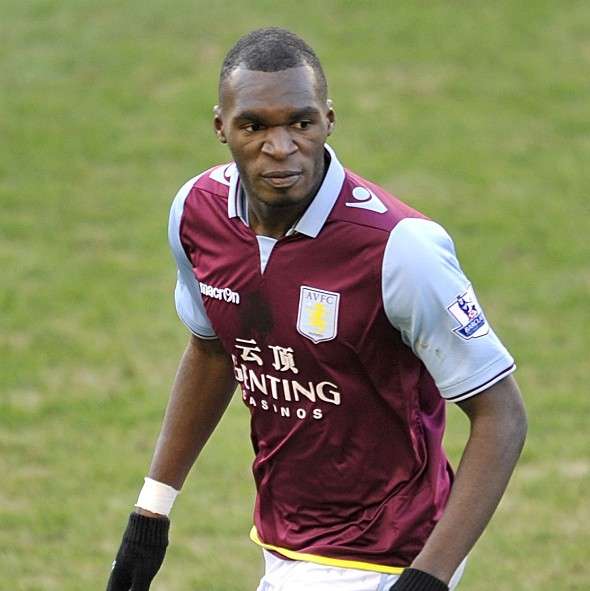Author: Will Humphrey
WSL newcomers Manchester United will be a major challenge for league leaders Chelsea
After the dismal showing by The Lionesses in front of a record crowd of 77,768 at Wembley, we can all breathe a big sigh of relief and get back to some Women’s Super League this weekend. There are several tasty looking fixtures too. It’s derby day on Merseyside and also in North London, but not to be outdone, league leaders Chelsea host new kids on the block Manchester United at The Cherry Red Records Stadium (the artistic ground formerly known as Kingsmeadow). According to expected goals, Emma Hayes’ Chelsea thoroughly deserve their top spot. Their non-penalty xG per game stands at 2.08, easily the best in the league, while the against figure is 0.65, narrowly second-best behind Arsenal’s. A goal and a half per game better off than opposition is impressive even if the opening fixtures have been fairly kind. Hayes has settled on a fairly robust 4-4-2-ish set up in recent weeks with either Fran Kirby or Ramona Bachmann playing slightly off the ever-ready Bethany England up front. With Chelsea putting teams on the back foot with their possession through a mix of both buildup from the back and direct balls into the channels, a lot of good attacking work comes from quick turnovers. Erin Cuthbert and Ji So-yun stand out in winning the ball back and Chelsea lead the way in high press shots. Here those two are combining for one of those: 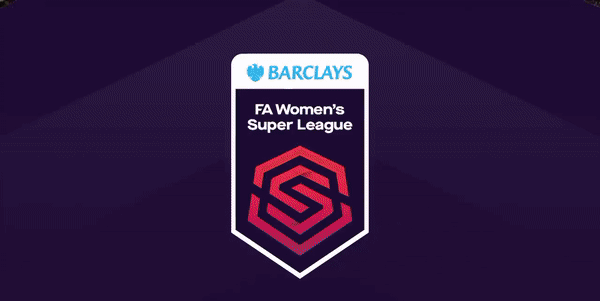 Ji is basically Chelsea’s go-to player. Dominant in so many metrics, the South Korean’s closest player match-ups in the Statsbomb database include Barcelona version Andres Iniesta, Liverpool version Philippe Coutinho and Manchester City’s David Silva. Enough said:
Ji is basically Chelsea’s go-to player. Dominant in so many metrics, the South Korean’s closest player match-ups in the Statsbomb database include Barcelona version Andres Iniesta, Liverpool version Philippe Coutinho and Manchester City’s David Silva. Enough said: 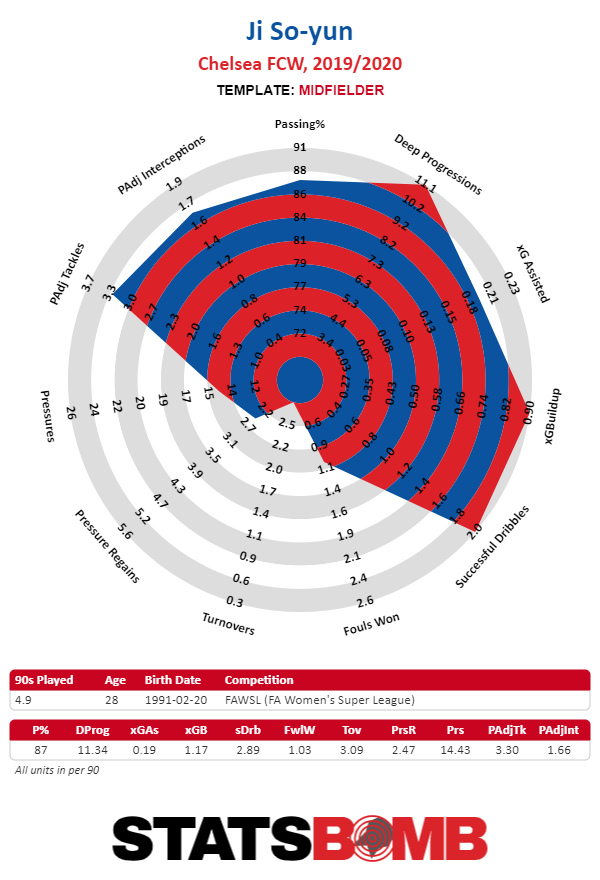 Even against champions Arsenal, playing in a two v three in the middle of the park, she’s bossing it:
Even against champions Arsenal, playing in a two v three in the middle of the park, she’s bossing it: 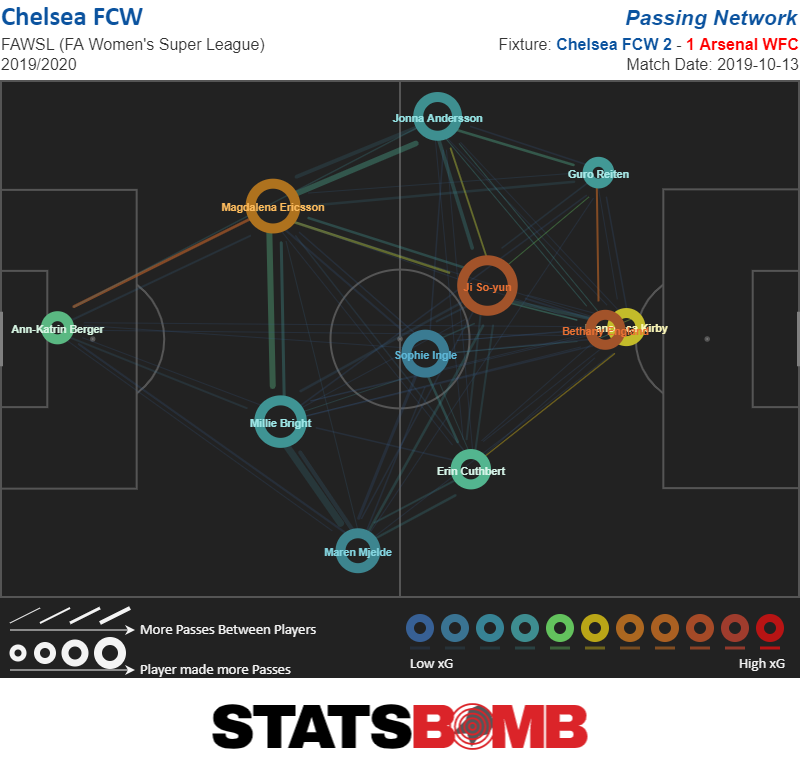 What of Casey Stoney’s Red Devils, then? United currently sit fourth in the non-penalty xG difference table at 0.51 per game and sit fourth in the actual table too, leaders of the ‘best of the rest' group. That’s pretty impressive for a newly promoted side, no? With impossibly horrific opening fixtures against Manchester City and Arsenal, followed by Liverpool, Reading and Spurs, Stoney has tinkered about with the side, setting them up differently almost every time. Consequently, the squad has been well rotated already. Whoever is picked, though, it’s fair to say United like to defend deep and bring the opposition on:
What of Casey Stoney’s Red Devils, then? United currently sit fourth in the non-penalty xG difference table at 0.51 per game and sit fourth in the actual table too, leaders of the ‘best of the rest' group. That’s pretty impressive for a newly promoted side, no? With impossibly horrific opening fixtures against Manchester City and Arsenal, followed by Liverpool, Reading and Spurs, Stoney has tinkered about with the side, setting them up differently almost every time. Consequently, the squad has been well rotated already. Whoever is picked, though, it’s fair to say United like to defend deep and bring the opposition on: 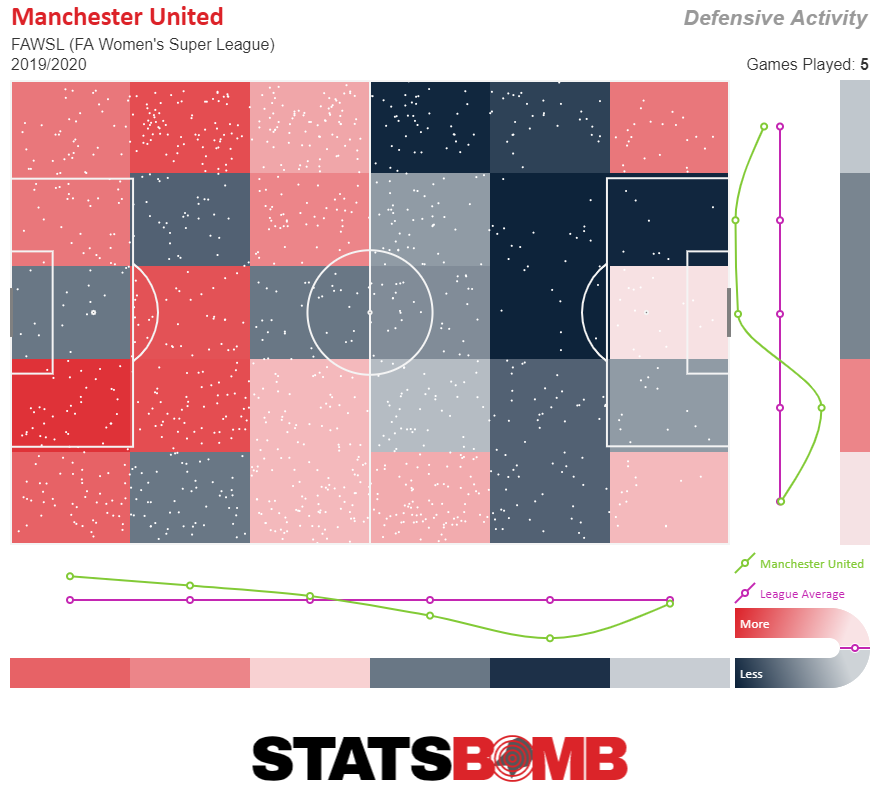 The team wallow at the bottom of the passes per defensive action (PPDA) table, allowing over 12 passes before making a defensive action. Even perennial bus parkers Bristol City get stuck in quicker than that. On average, United make their defensive moves well over 10 yards further back than upcoming opponents Chelsea. In goal, England No.1 Mary Earps is fairly well protected, as United are pretty good at preventing high-value shots, second only to Arsenal. She's having a good season so far, conceding only 2 goals when post-shot xG would expect nearly 5. While for England, Phil Neville has her playing out from the back, at United, she goes longer than any other keeper in the league. This showed while watching the England match live last Saturday. Earps didn’t appear switched on enough to doing things quickly and looked slow and deliberate with the ball at her feet. To be fair, however, Steph Houghton and Leah Williamson were also in a daze too. Left-sided midfielder, Katie Zelem is generally the hub of the team. That considered, you can see from her radar that perhaps United aren’t a run of the mill side:
The team wallow at the bottom of the passes per defensive action (PPDA) table, allowing over 12 passes before making a defensive action. Even perennial bus parkers Bristol City get stuck in quicker than that. On average, United make their defensive moves well over 10 yards further back than upcoming opponents Chelsea. In goal, England No.1 Mary Earps is fairly well protected, as United are pretty good at preventing high-value shots, second only to Arsenal. She's having a good season so far, conceding only 2 goals when post-shot xG would expect nearly 5. While for England, Phil Neville has her playing out from the back, at United, she goes longer than any other keeper in the league. This showed while watching the England match live last Saturday. Earps didn’t appear switched on enough to doing things quickly and looked slow and deliberate with the ball at her feet. To be fair, however, Steph Houghton and Leah Williamson were also in a daze too. Left-sided midfielder, Katie Zelem is generally the hub of the team. That considered, you can see from her radar that perhaps United aren’t a run of the mill side: 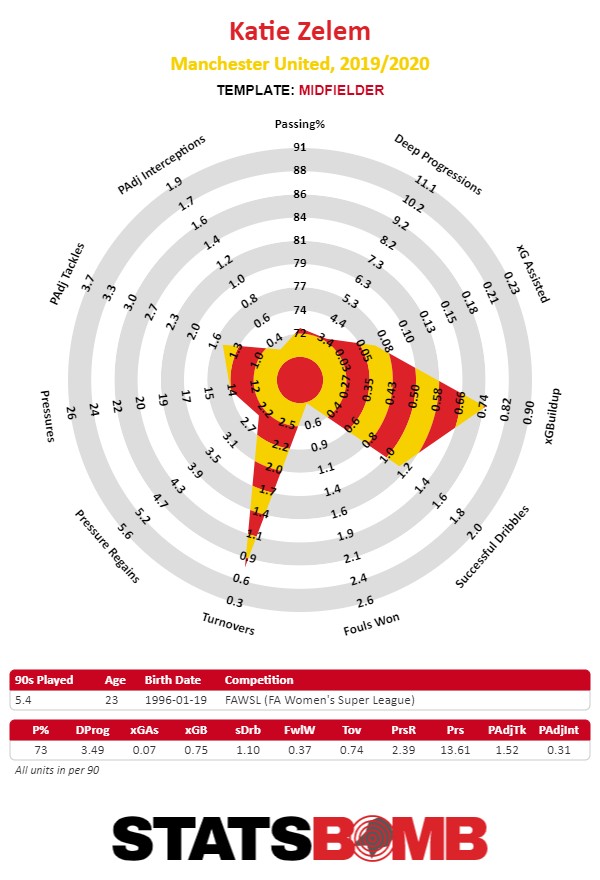 The pass sonar for Zelem also reveals how United might want to play Chelsea. Zelem’s pass completion is perhaps represented by how often the vertical ball is chosen over merely recycling possession.
The pass sonar for Zelem also reveals how United might want to play Chelsea. Zelem’s pass completion is perhaps represented by how often the vertical ball is chosen over merely recycling possession. 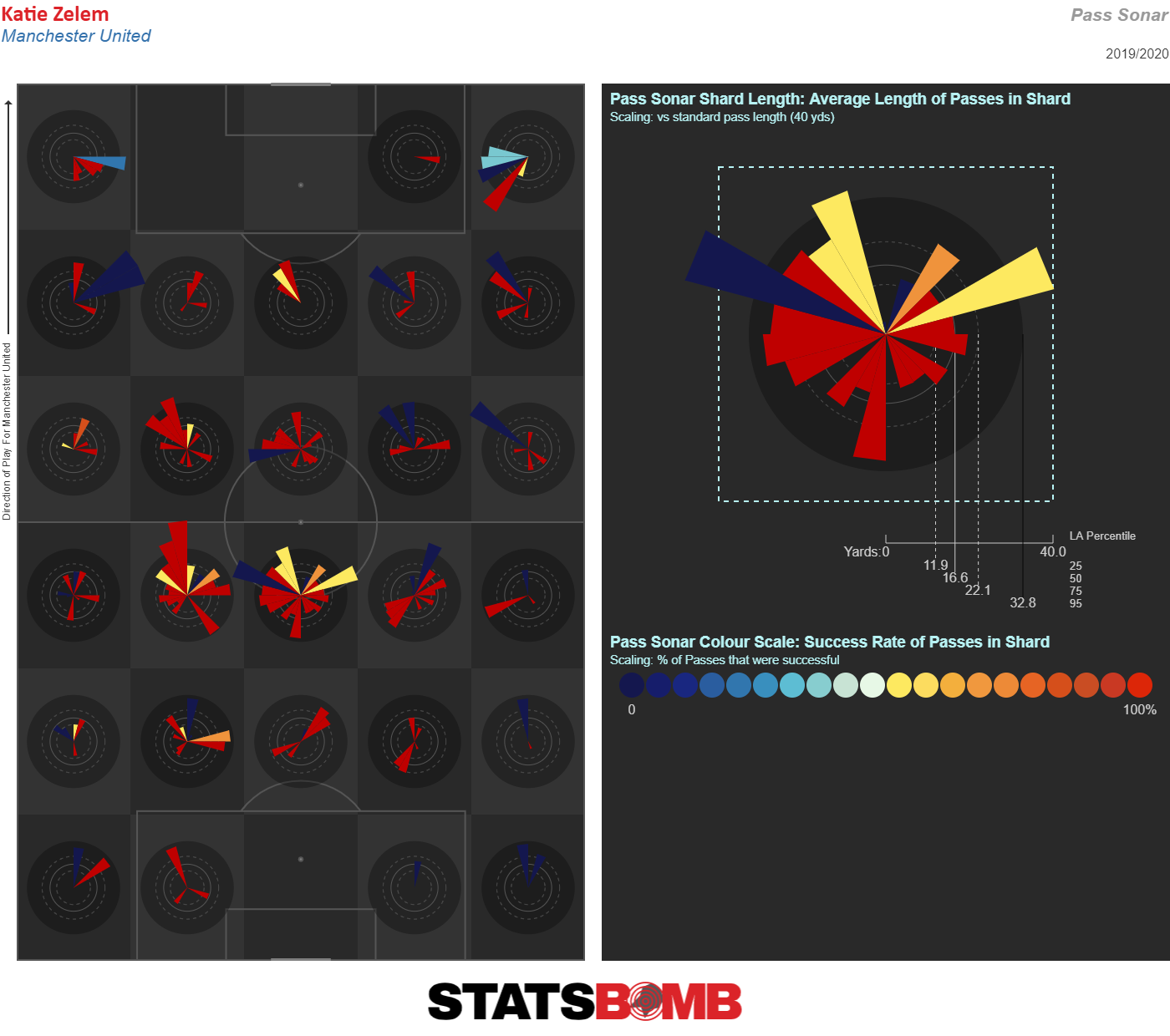 Looking back at the defensive viz for United we can see defensive pressure being applied into the far corners. In the opener against City, United repeatedly sent the ball down the sides and chased the superior footballing team backwards. United hunted in packs of 3s and 4s, bombing on to put City under pressure. This accomplished two things: it made them a threat on the counter, and forced City as far away from goal as possible, having to build moves from their own box while having opposition players cutting off passing lanes. Ultimately it didn’t work, but United did create good chances and were really unlucky not to score. It is almost written in stone that Chelsea will dominate the ball in this fixture, and it will be a fascinating cat and mouse game if United can prevent Chelsea from scoring early on. That's a big if, however. United are a physical team but so are Chelsea. United look like they can run all day at times, but if there’s one side that will stand up and fight it’s Chelsea. I wouldn’t be surprised if Chelsea make United pay at corners. I’m not convinced by Earps’ ability to relieve the pressure there. Chelsea have good routines and good aerial ability while United have the worst numbers in the league when it comes to conceding chances at corners. United do have a wildcard in youngster Lauren James. I first saw James properly last season running rings around older players and generally making things look too easy. Therein also lies James’ problem. All too often it seems so easy for her that she can’t be bothered. It would be brilliant if she turned up and shone in a big game like this. As it is, I’m not even sure she’ll make the starting line-up. Which is a shame because she can do this:
Looking back at the defensive viz for United we can see defensive pressure being applied into the far corners. In the opener against City, United repeatedly sent the ball down the sides and chased the superior footballing team backwards. United hunted in packs of 3s and 4s, bombing on to put City under pressure. This accomplished two things: it made them a threat on the counter, and forced City as far away from goal as possible, having to build moves from their own box while having opposition players cutting off passing lanes. Ultimately it didn’t work, but United did create good chances and were really unlucky not to score. It is almost written in stone that Chelsea will dominate the ball in this fixture, and it will be a fascinating cat and mouse game if United can prevent Chelsea from scoring early on. That's a big if, however. United are a physical team but so are Chelsea. United look like they can run all day at times, but if there’s one side that will stand up and fight it’s Chelsea. I wouldn’t be surprised if Chelsea make United pay at corners. I’m not convinced by Earps’ ability to relieve the pressure there. Chelsea have good routines and good aerial ability while United have the worst numbers in the league when it comes to conceding chances at corners. United do have a wildcard in youngster Lauren James. I first saw James properly last season running rings around older players and generally making things look too easy. Therein also lies James’ problem. All too often it seems so easy for her that she can’t be bothered. It would be brilliant if she turned up and shone in a big game like this. As it is, I’m not even sure she’ll make the starting line-up. Which is a shame because she can do this: 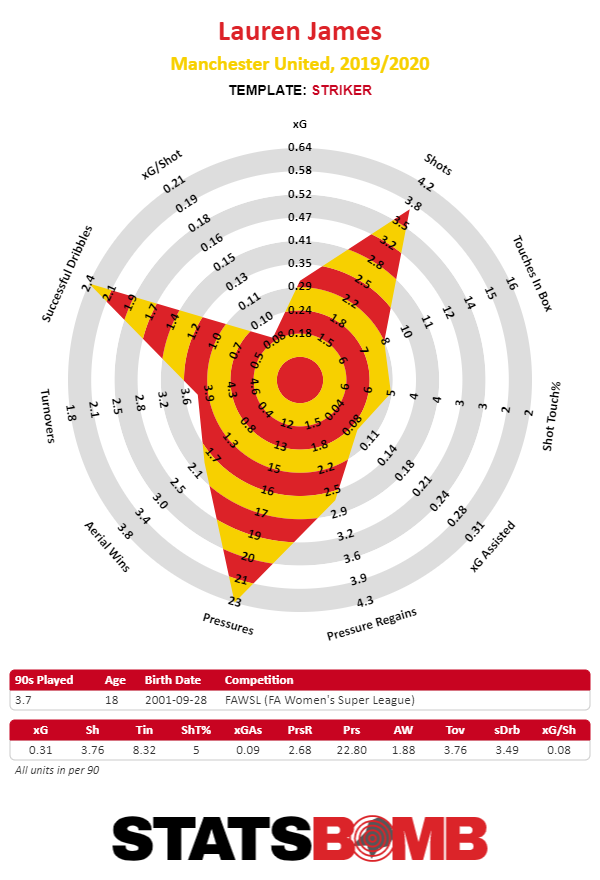
The Super League's action filled (ish) opening weekend
Last season Bristol City were able to secure seven wins from 20 games despite scoring just 17 goals. Weekend opponents Brighton scored just 16 goals and won four games. The FA Women’s Super League media team must have been absolutely chuffed when they found out the powers that be had made this fixture one of the two opening games to be televised. Both side’s defensive activity maps last year were things to behold. There’s sitting deep, and there’s sitting deep, and there’s Bristol City and Brighton: 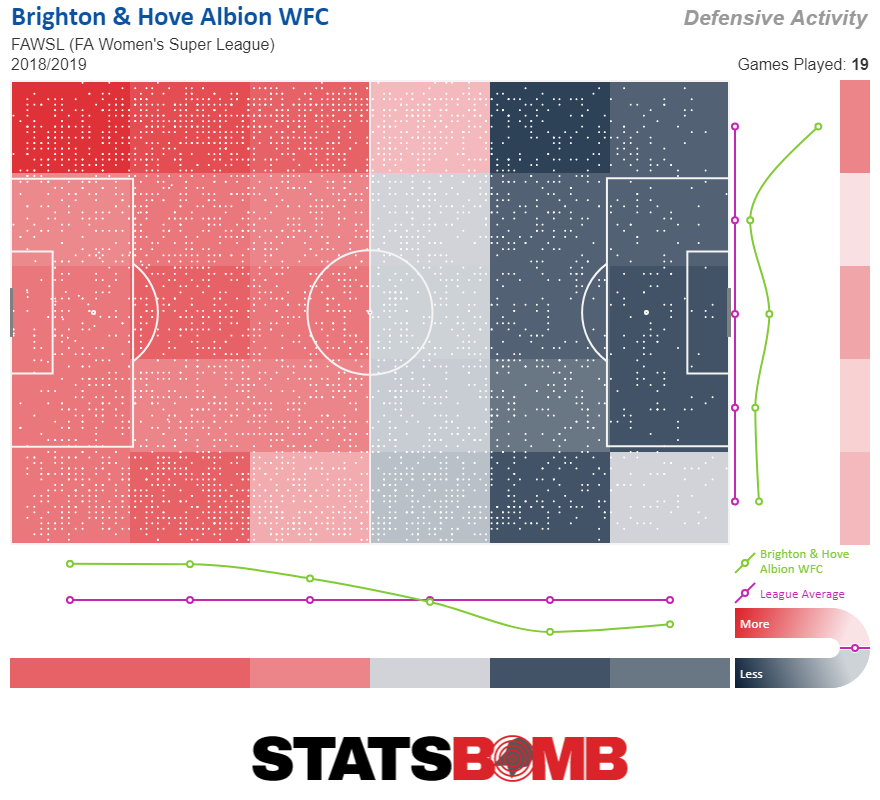
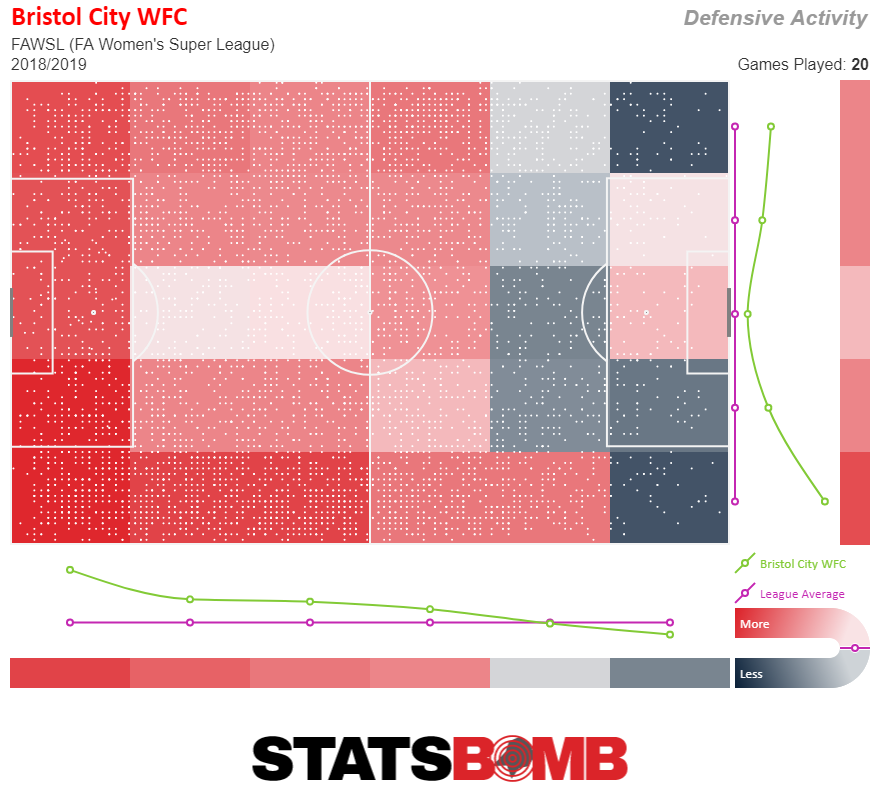 No surprise then that the game ended 0-0. However! Despite the similar outputs at season’s end in terms of goals, the underlying numbers suggested Brighton created nearly twice the amount of goal threat in terms of expected goals during the 2018-19 season. And that seemed to bear out in this game as Hope Powell’s Seagulls repeatedly pecked away at Tanya Oxtoby’s Vixens. By half time the shot count was 13-1 in Brighton’s favour (including a penalty brilliantly saved by Sophie Baggaley). At 75 minutes, that count had extended to 21-1. The introduction of Ebony Salmon and Olivia Chance stretched the game a little and there was a late flurry of activity but it still looked like this at the end:
No surprise then that the game ended 0-0. However! Despite the similar outputs at season’s end in terms of goals, the underlying numbers suggested Brighton created nearly twice the amount of goal threat in terms of expected goals during the 2018-19 season. And that seemed to bear out in this game as Hope Powell’s Seagulls repeatedly pecked away at Tanya Oxtoby’s Vixens. By half time the shot count was 13-1 in Brighton’s favour (including a penalty brilliantly saved by Sophie Baggaley). At 75 minutes, that count had extended to 21-1. The introduction of Ebony Salmon and Olivia Chance stretched the game a little and there was a late flurry of activity but it still looked like this at the end: 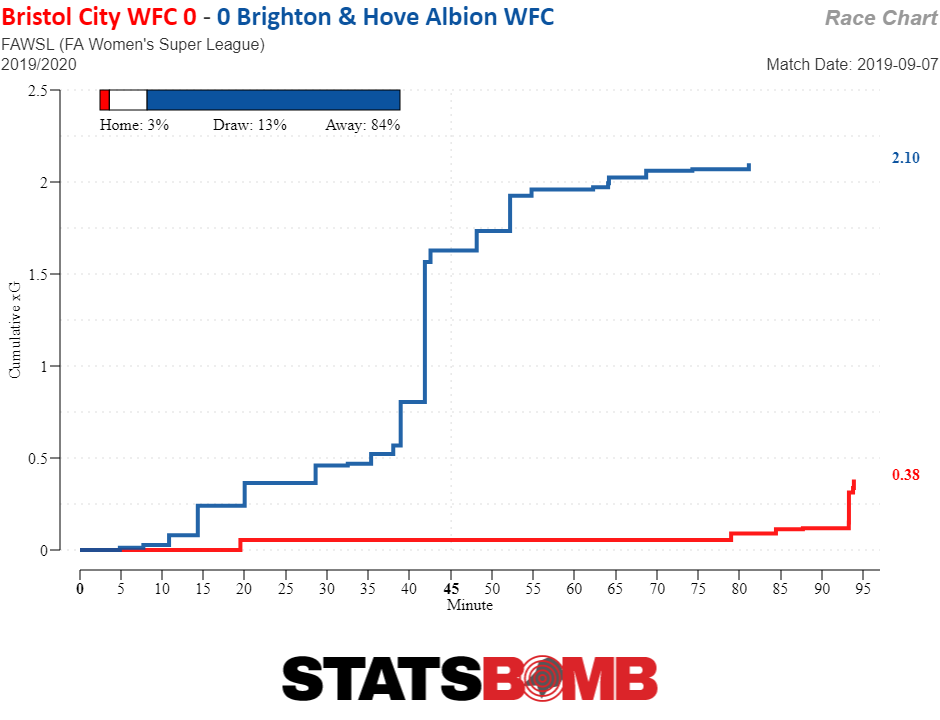 Ouch. The worry for Powell is that not taking chances, a habit that plagued Brighton last year, has already rolled over into the new season. Both main striking options, Kayleigh Green and Iniabasi Umotong, were culprits last season, ending up with goal tallies at nearly half of their xG totals. The positive is that the 2.1 xG posted here was as good as anything Brighton managed last year. The negative is that those high xG postings last year were against relegated Yeovil. And Bristol City may end up as this year’s Yeovil if they’re not careful. Chelsea took on Tottenham in front of a big crowd at Stamford Bridge and according to shots and xG it was another one-sided game. Newcomers Tottenham started conservatively with Ria Percival tasked to sit in front of the back four to protect and screen whilst watching the keeper and defenders play tippy-tap out from the back. It didn’t start well. In Spurs’ first build up, Percival (No.3) did her best to make a show of looking to receive the ball while never actually intending to. She was wrong-footed trying to move away from play just as the pass came, leaving Bethany England to pick the ball up and smash it into the top corner. It really was brutal punishment for Spurs starting in neutral:
Ouch. The worry for Powell is that not taking chances, a habit that plagued Brighton last year, has already rolled over into the new season. Both main striking options, Kayleigh Green and Iniabasi Umotong, were culprits last season, ending up with goal tallies at nearly half of their xG totals. The positive is that the 2.1 xG posted here was as good as anything Brighton managed last year. The negative is that those high xG postings last year were against relegated Yeovil. And Bristol City may end up as this year’s Yeovil if they’re not careful. Chelsea took on Tottenham in front of a big crowd at Stamford Bridge and according to shots and xG it was another one-sided game. Newcomers Tottenham started conservatively with Ria Percival tasked to sit in front of the back four to protect and screen whilst watching the keeper and defenders play tippy-tap out from the back. It didn’t start well. In Spurs’ first build up, Percival (No.3) did her best to make a show of looking to receive the ball while never actually intending to. She was wrong-footed trying to move away from play just as the pass came, leaving Bethany England to pick the ball up and smash it into the top corner. It really was brutal punishment for Spurs starting in neutral: 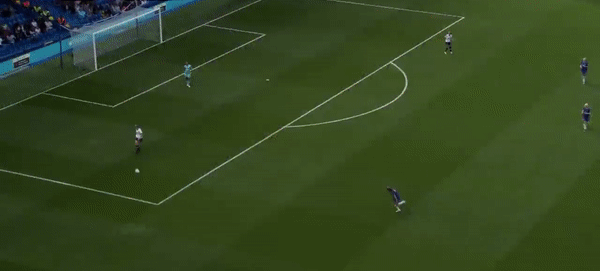 Percival continued to trundle about protecting the space in front of back four rather than aggressively seeking to destroy. She also continued to walk about and look entirely uninterested in receiving the ball during Tottenham’s build up play, appearing to tell team mates to calm down and ignore her as an option:
Percival continued to trundle about protecting the space in front of back four rather than aggressively seeking to destroy. She also continued to walk about and look entirely uninterested in receiving the ball during Tottenham’s build up play, appearing to tell team mates to calm down and ignore her as an option: 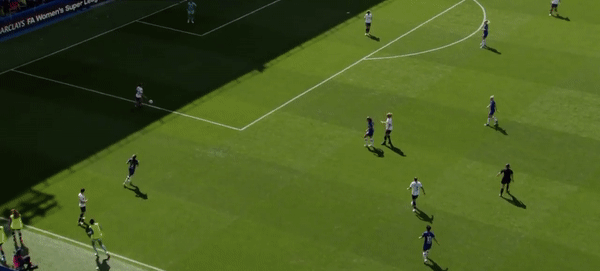
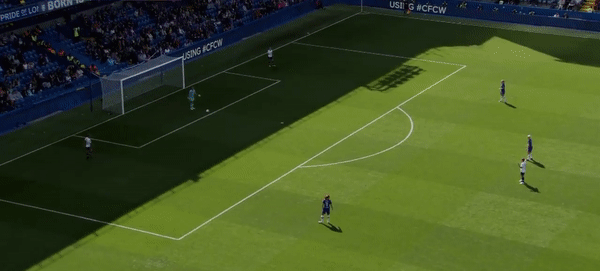 One nil down at half time, it looked like Spurs’ manager Karen Hills had to do something other than keep the ball away from Chelsea’s central midfield. And she did. On came Chloe Peplow for Coral Haines with Percival moved further forward. It started to look much better on the eye. Peplow (No.8) was immediately more aggressive and higher up the pitch in possession:
One nil down at half time, it looked like Spurs’ manager Karen Hills had to do something other than keep the ball away from Chelsea’s central midfield. And she did. On came Chloe Peplow for Coral Haines with Percival moved further forward. It started to look much better on the eye. Peplow (No.8) was immediately more aggressive and higher up the pitch in possession: 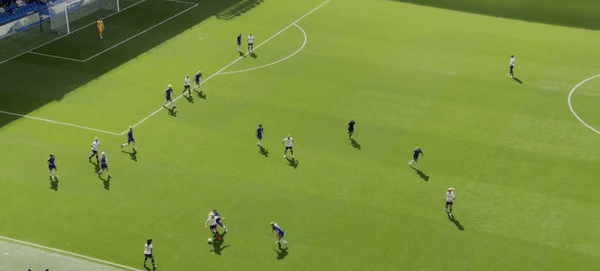 She was also more dynamic in build-up from the back, actually offering for the ball and then moving her marker around to create room to switch the ball around:
She was also more dynamic in build-up from the back, actually offering for the ball and then moving her marker around to create room to switch the ball around: 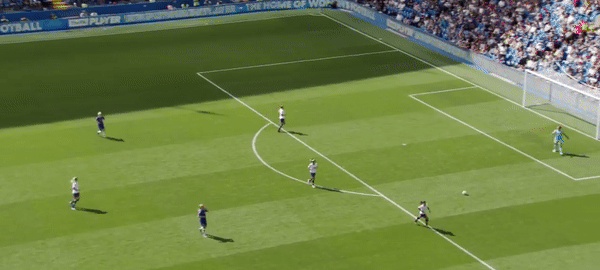
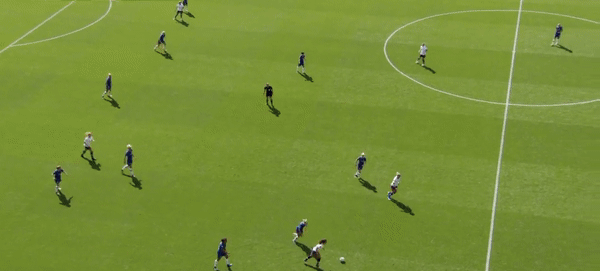 The effect on possession of the ball can be seen by comparing the pass networks before and after the break:
The effect on possession of the ball can be seen by comparing the pass networks before and after the break: 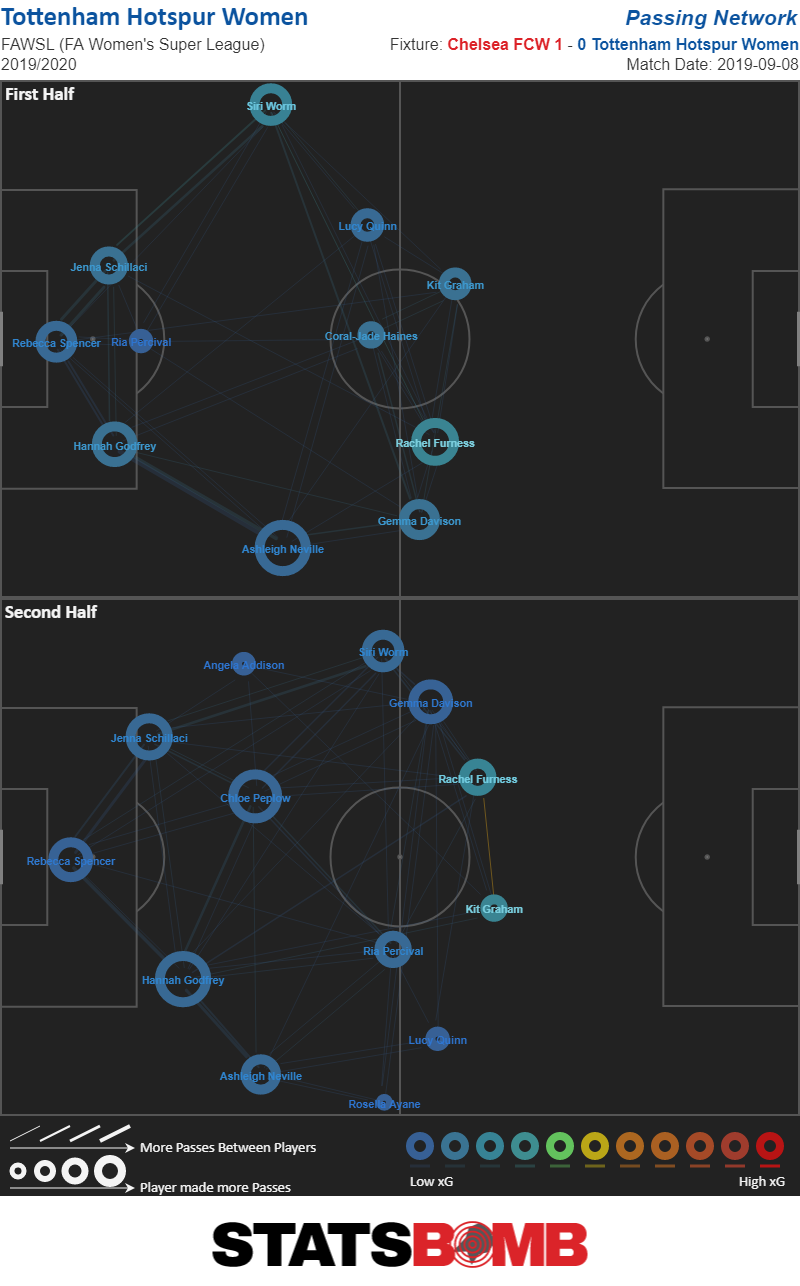 That said, it didn’t alter the flow of traffic in terms of attacking. Chelsea continued to dominate the shot count and the numbers were resoundingly in the Blues’ favour: I have to say, despite this awful looking chart, I enjoyed Tottenham’s performance.
That said, it didn’t alter the flow of traffic in terms of attacking. Chelsea continued to dominate the shot count and the numbers were resoundingly in the Blues’ favour: I have to say, despite this awful looking chart, I enjoyed Tottenham’s performance. 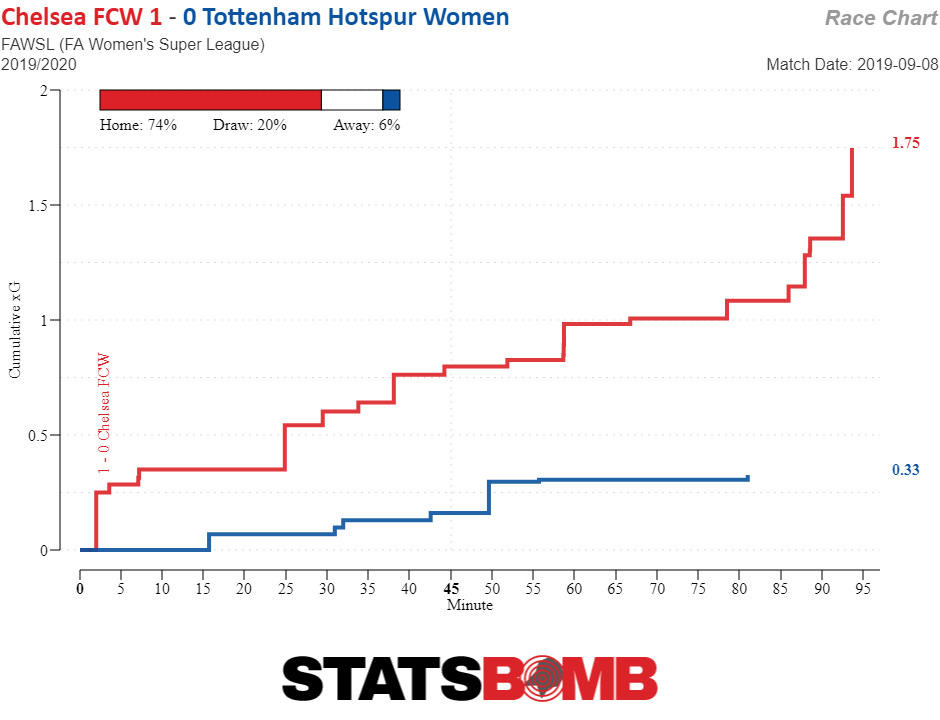 The first half plan of trying to stifle Chelsea and play down the sides wasn’t successful but at least Spurs’ were trying to stick to their principles of trying to build from the back. It gave the first half pass map the classic U-shaped look that connoisseurs of more direct football (people like me) are so fond of calling impolite words:
The first half plan of trying to stifle Chelsea and play down the sides wasn’t successful but at least Spurs’ were trying to stick to their principles of trying to build from the back. It gave the first half pass map the classic U-shaped look that connoisseurs of more direct football (people like me) are so fond of calling impolite words: 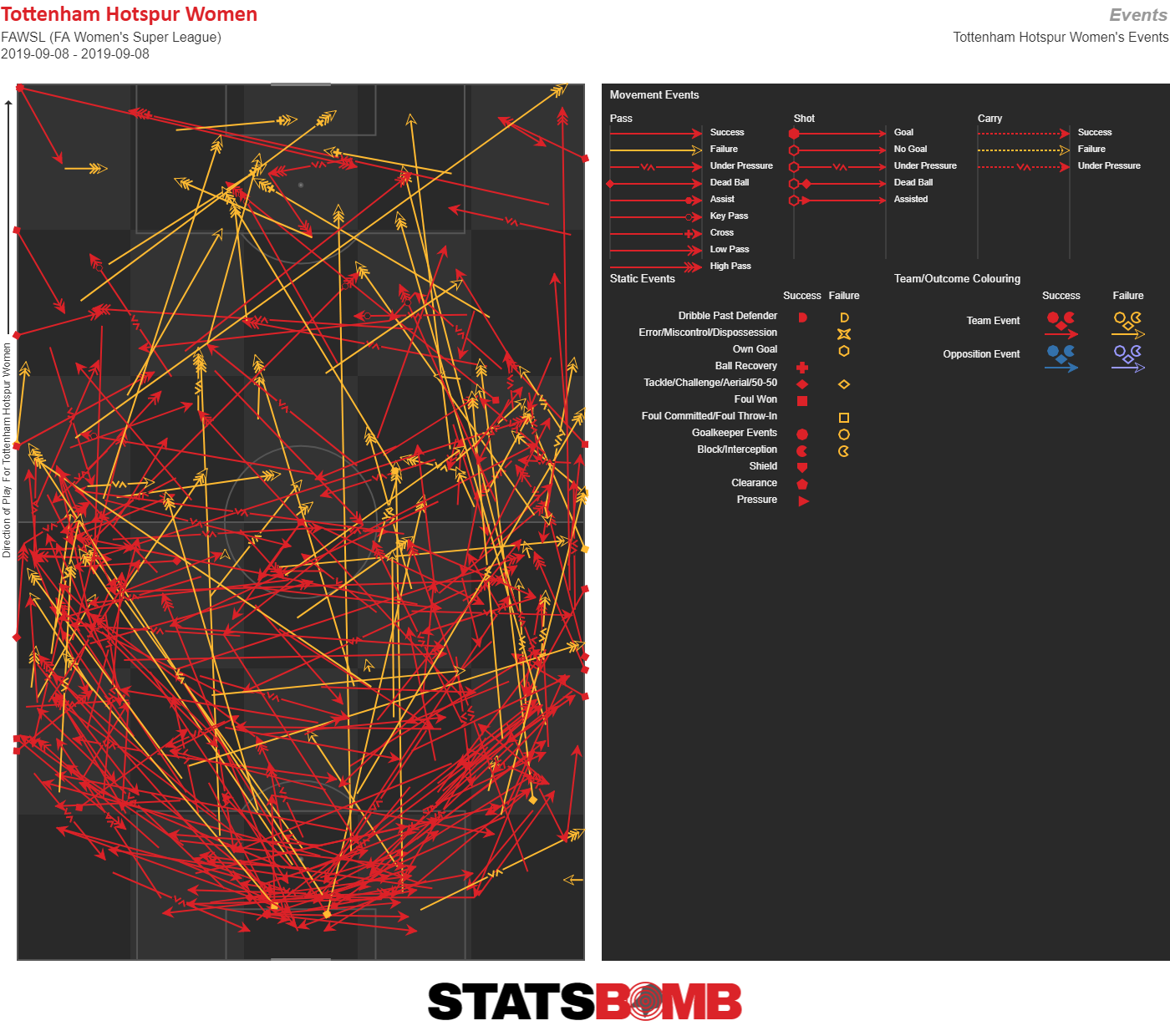 Still, despite Chelsea racking up the shots, Tottenham seemed fairly well drilled in defence and kept shape. Chelsea just looked more able physically. And had better players. Going forward, the odd attack on the break through Gemma Davison’s ball carrying and Siri Worm’s charges down the left felt more dangerous than the numbers suggested. Tottenham’s riskier second-half approach felt encouraging and should instil a bit of belief that against sides of lesser quality than Chelsea, this Spurs team should be able to mix it. Increasingly these days I’m in favour of teams using these ‘throwaway’ fixtures (against far superior opposition) to concentrate on their own game to help future performances - especially in a league as disparate and short in games as FAWSL. Arsenal, Manchester City and Chelsea are in a league of their own according to recent historic xG numbers. With a small number of fixtures to play against more evenly matched teams, is it worth wasting a few weeks a season practicing specific defensive game plans in the forlorn hope of snatching a point? It may be for Bristol City who’ll do it whoever they face, but Spurs and the rest? Not so much. I was therefore impressed with West Ham’s showing against Champions, Arsenal. Manager Matt Beard set the Irons up to have a decent go and so they did:
Still, despite Chelsea racking up the shots, Tottenham seemed fairly well drilled in defence and kept shape. Chelsea just looked more able physically. And had better players. Going forward, the odd attack on the break through Gemma Davison’s ball carrying and Siri Worm’s charges down the left felt more dangerous than the numbers suggested. Tottenham’s riskier second-half approach felt encouraging and should instil a bit of belief that against sides of lesser quality than Chelsea, this Spurs team should be able to mix it. Increasingly these days I’m in favour of teams using these ‘throwaway’ fixtures (against far superior opposition) to concentrate on their own game to help future performances - especially in a league as disparate and short in games as FAWSL. Arsenal, Manchester City and Chelsea are in a league of their own according to recent historic xG numbers. With a small number of fixtures to play against more evenly matched teams, is it worth wasting a few weeks a season practicing specific defensive game plans in the forlorn hope of snatching a point? It may be for Bristol City who’ll do it whoever they face, but Spurs and the rest? Not so much. I was therefore impressed with West Ham’s showing against Champions, Arsenal. Manager Matt Beard set the Irons up to have a decent go and so they did: 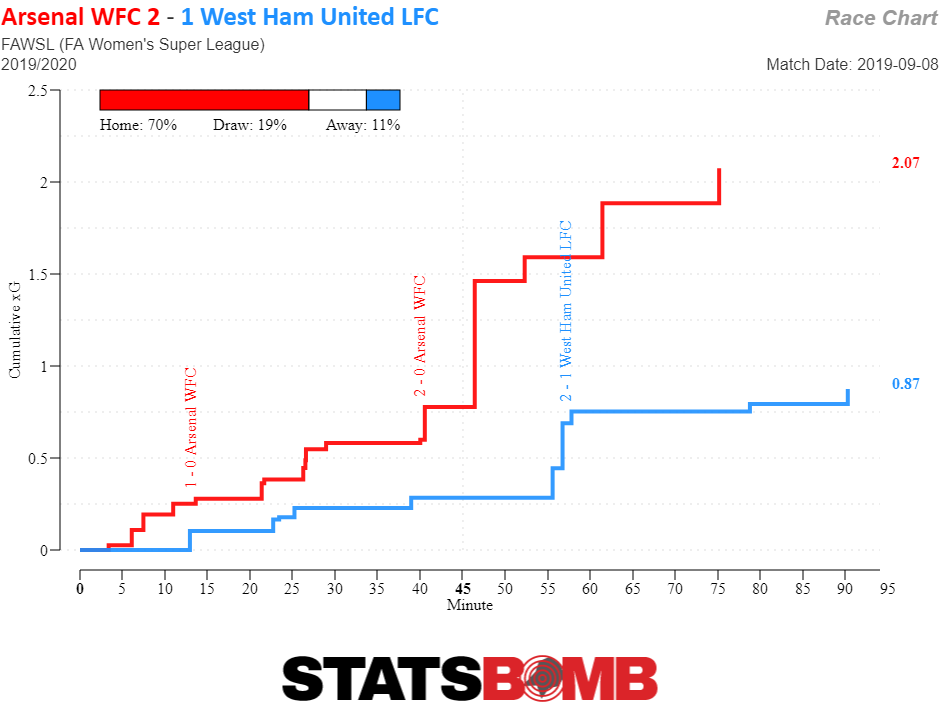 The front two, Martha Thomas and Kenza Dali, both brought in from French clubs look an intriguing pairing. Dali dropped deep to pull the strings while Thomas harried and harassed and scored an absolutely brilliant header, rising and nipping in front of her marker to steer the ball inside the post. This is the first time I’ve seen Thomas who played college soccer in the US before moving to Division 2 side Le Havre. She looked to have everything you’d want in a forward – pace, aerial ability, an eye for goal and a good old-fashioned enthusiasm for terrifying defenders. The Hammer’s certainly needed more creativity and firepower up front to improve last season’s middling numbers. As you can see from the trendline below, defence was perhaps the bigger problem for Beard early on in the season. Things got better as winter drew in:
The front two, Martha Thomas and Kenza Dali, both brought in from French clubs look an intriguing pairing. Dali dropped deep to pull the strings while Thomas harried and harassed and scored an absolutely brilliant header, rising and nipping in front of her marker to steer the ball inside the post. This is the first time I’ve seen Thomas who played college soccer in the US before moving to Division 2 side Le Havre. She looked to have everything you’d want in a forward – pace, aerial ability, an eye for goal and a good old-fashioned enthusiasm for terrifying defenders. The Hammer’s certainly needed more creativity and firepower up front to improve last season’s middling numbers. As you can see from the trendline below, defence was perhaps the bigger problem for Beard early on in the season. Things got better as winter drew in: 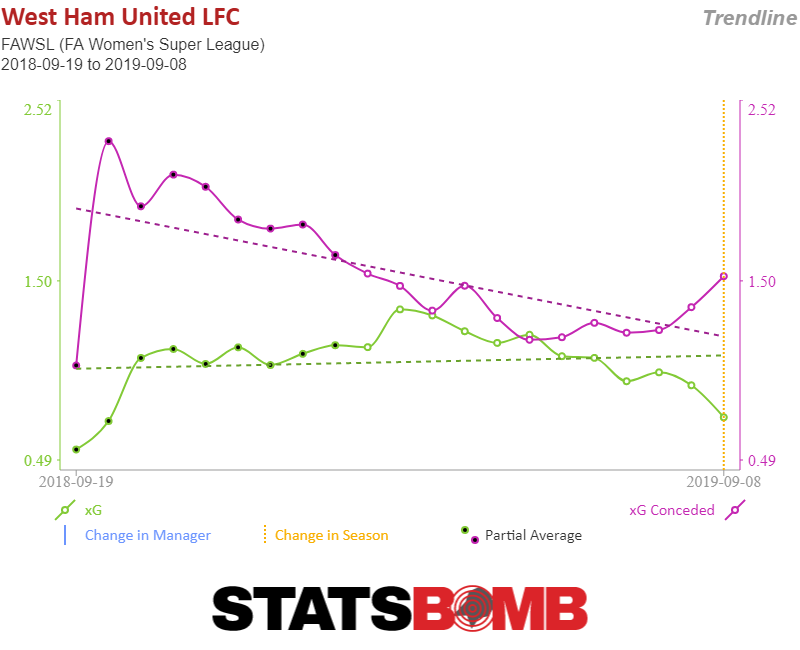 However, still clearly feeling the need for reinforcements, West Ham signed left-sided German defensive duo Katharina Baunach and Laura Vetterlein in the summer along with right-back Cecilie Kvamme. All got game time this weekend but couldn’t stem the Arsenal tide. What they all did do, however, was get heavily involved in build-up. Midfielder, Tessel Middag, finally got to play some football in this country following two consecutive ACL injuries. The Dutch international will feel she has some catching up to do. West Ham are going to be an interesting side to watch this year. Newly promoted Manchester United complete my hattrick of plucky losers on opening weekend. The difference here is they actually beat Manchester City on the xG count 0.78 to 0.40 even if they did get beat in reality. No team managed to restrict City that much in a game last season. So how did United do it? Like Spurs, United tried to play round the outside of the opponent. They also created a nice U-shape for the pass map but they did something different too. They continually sent the ball long into wide areas and the inside channels:
However, still clearly feeling the need for reinforcements, West Ham signed left-sided German defensive duo Katharina Baunach and Laura Vetterlein in the summer along with right-back Cecilie Kvamme. All got game time this weekend but couldn’t stem the Arsenal tide. What they all did do, however, was get heavily involved in build-up. Midfielder, Tessel Middag, finally got to play some football in this country following two consecutive ACL injuries. The Dutch international will feel she has some catching up to do. West Ham are going to be an interesting side to watch this year. Newly promoted Manchester United complete my hattrick of plucky losers on opening weekend. The difference here is they actually beat Manchester City on the xG count 0.78 to 0.40 even if they did get beat in reality. No team managed to restrict City that much in a game last season. So how did United do it? Like Spurs, United tried to play round the outside of the opponent. They also created a nice U-shape for the pass map but they did something different too. They continually sent the ball long into wide areas and the inside channels: 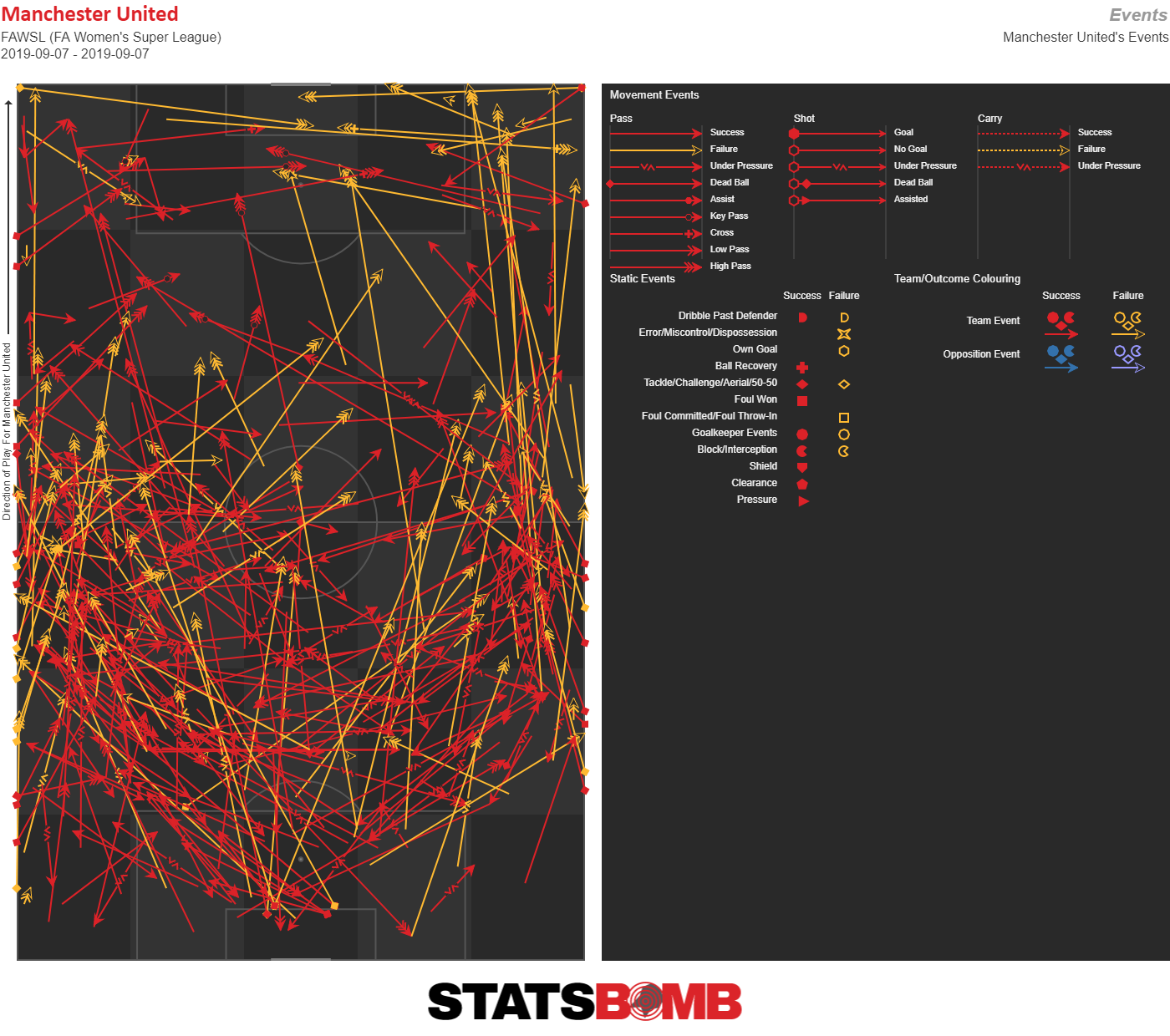 This enabled two things. Firstly, an ability to create chances by turning City towards their own goal:
This enabled two things. Firstly, an ability to create chances by turning City towards their own goal: 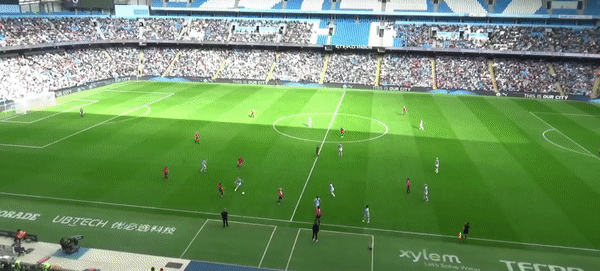
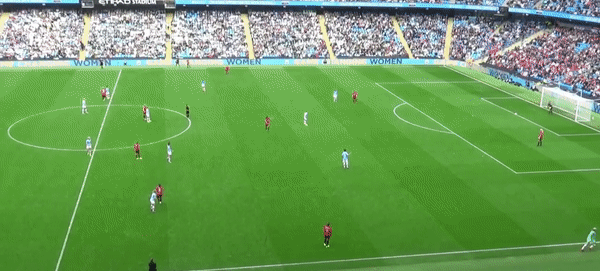 Look how many United players bomb on in support in those clips making it 4v4 and 3v3. Secondly, even when the ball was given away, the long ball and application of pressure meant City had to build from their own third rather than on half way. This happened again and again. It was really aggressive from United and kept City far away from the danger zones. There are plenty of routes to watching live FAWSL games for free this season. If you haven’t yet, then you should. It’s a product that’s going to get better and better and better. And Statsbomb have all the data, and it's all free if teams want it.
Look how many United players bomb on in support in those clips making it 4v4 and 3v3. Secondly, even when the ball was given away, the long ball and application of pressure meant City had to build from their own third rather than on half way. This happened again and again. It was really aggressive from United and kept City far away from the danger zones. There are plenty of routes to watching live FAWSL games for free this season. If you haven’t yet, then you should. It’s a product that’s going to get better and better and better. And Statsbomb have all the data, and it's all free if teams want it.
Jean-Philippe Gbamin, Player Profile
It’s been a baptism of fire for Jean-Philippe Gbamin in an Everton jersey. On after 45 minutes on opening day to replace fan favourite André Gomes. Midfield partner Morgan Schneiderlin sent off 30 minutes later. Alongside new partner Tom Davies for the last 20 minutes with 10 men. And to top it off he was a starter this week to partner Gomes against tough Watford duo Abdoulaye Doucouré and Étienne Capoue. And breathe. It’s fair to say a few Evertonians wobbled at JP’s wobbles, particularly in that first game against Crystal Palace. Will the real Gbamin please stand up? We’re here at Statsbomb Towers, so let’s have a look at his radar: 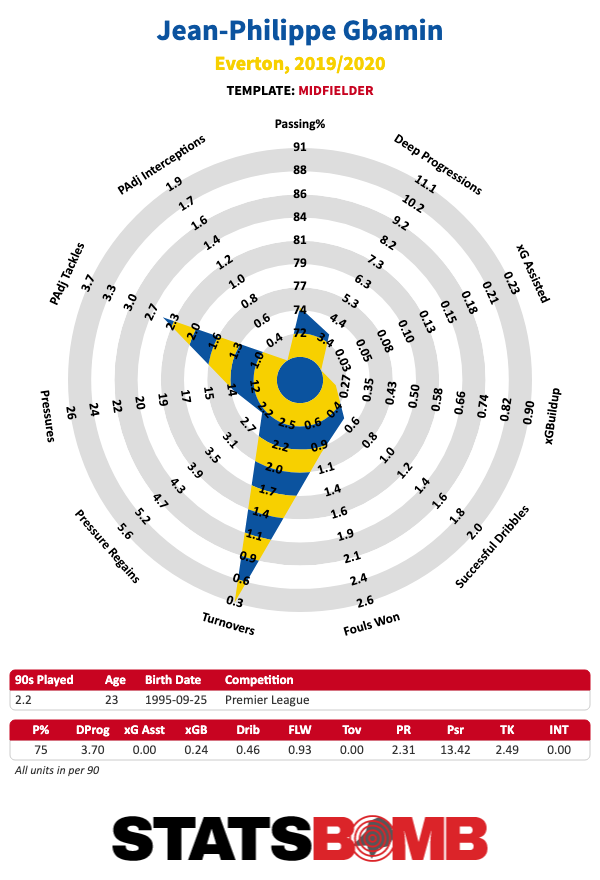 So yeah, moving swiftly on to a comparison with last season’s radar at Mainz. What else is in his locker?
So yeah, moving swiftly on to a comparison with last season’s radar at Mainz. What else is in his locker? 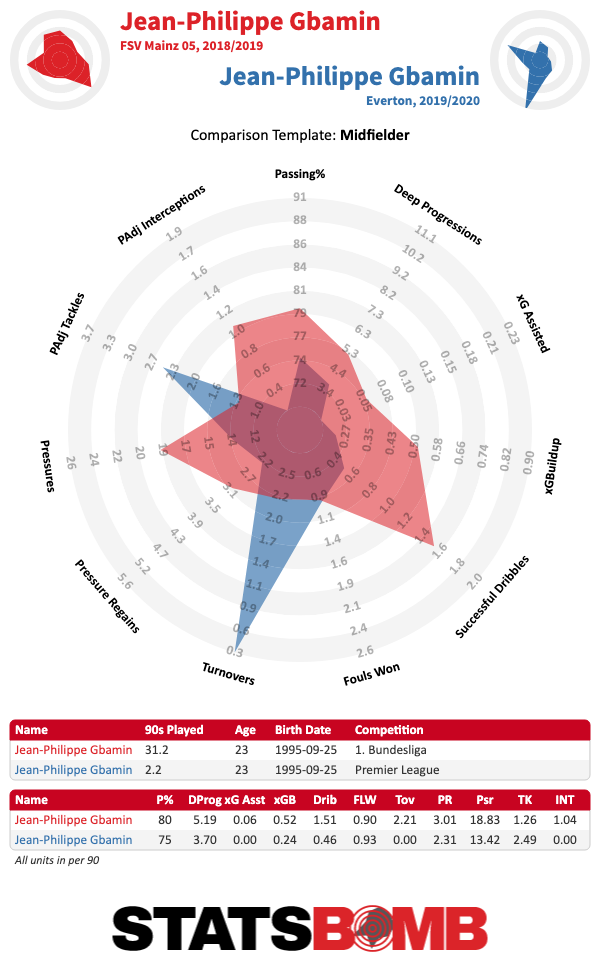 Ok, so still nothing amazing. But extra facets to his game there that we’ve not seen yet in the small sample of 120 minutes so far at Everton. His passing can be better, he can carry the ball nicely, and he can press the ball more. Good. Even though the sample is small, the different aspects of his play on the radar are mirrored in his defensive work at both clubs too. At Everton, he’s mainly stuck to the right-hand side of the pitch:
Ok, so still nothing amazing. But extra facets to his game there that we’ve not seen yet in the small sample of 120 minutes so far at Everton. His passing can be better, he can carry the ball nicely, and he can press the ball more. Good. Even though the sample is small, the different aspects of his play on the radar are mirrored in his defensive work at both clubs too. At Everton, he’s mainly stuck to the right-hand side of the pitch: 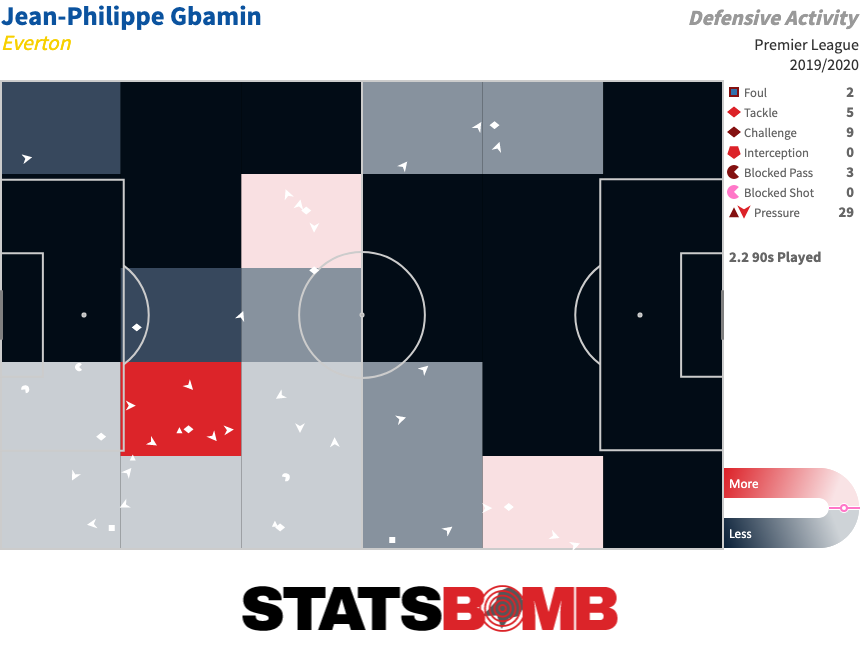 Despite starting nominally on the right side of the pitch at Mainz too, he still found a ton of time to roam the pitch much more freely to disrupt play:
Despite starting nominally on the right side of the pitch at Mainz too, he still found a ton of time to roam the pitch much more freely to disrupt play: 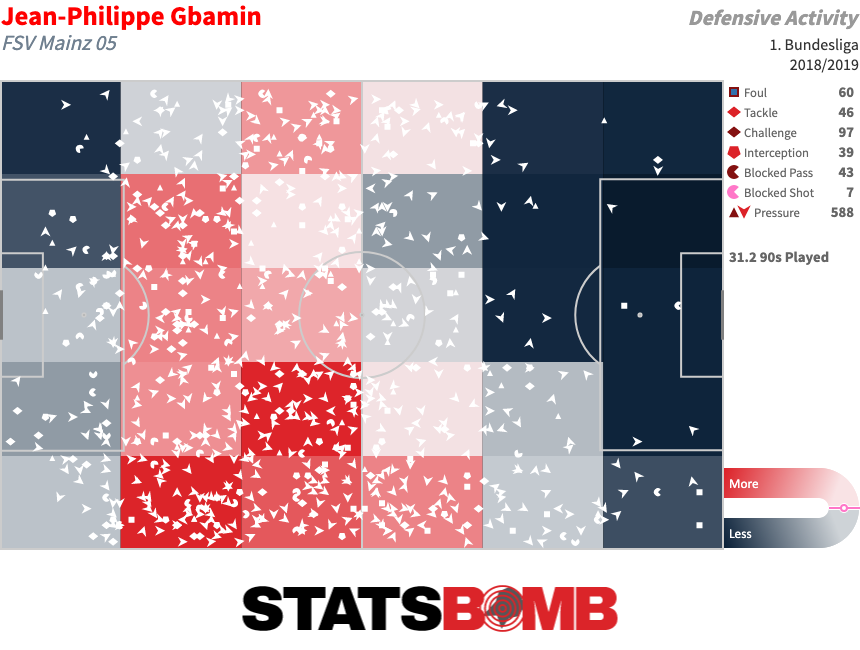 Are we likely to continue to see a more restricted Gbamin in Marco Silva’s line up? His shot map last season in the Bundesliga featured a fair few bombs. Two hit the target:
Are we likely to continue to see a more restricted Gbamin in Marco Silva’s line up? His shot map last season in the Bundesliga featured a fair few bombs. Two hit the target: 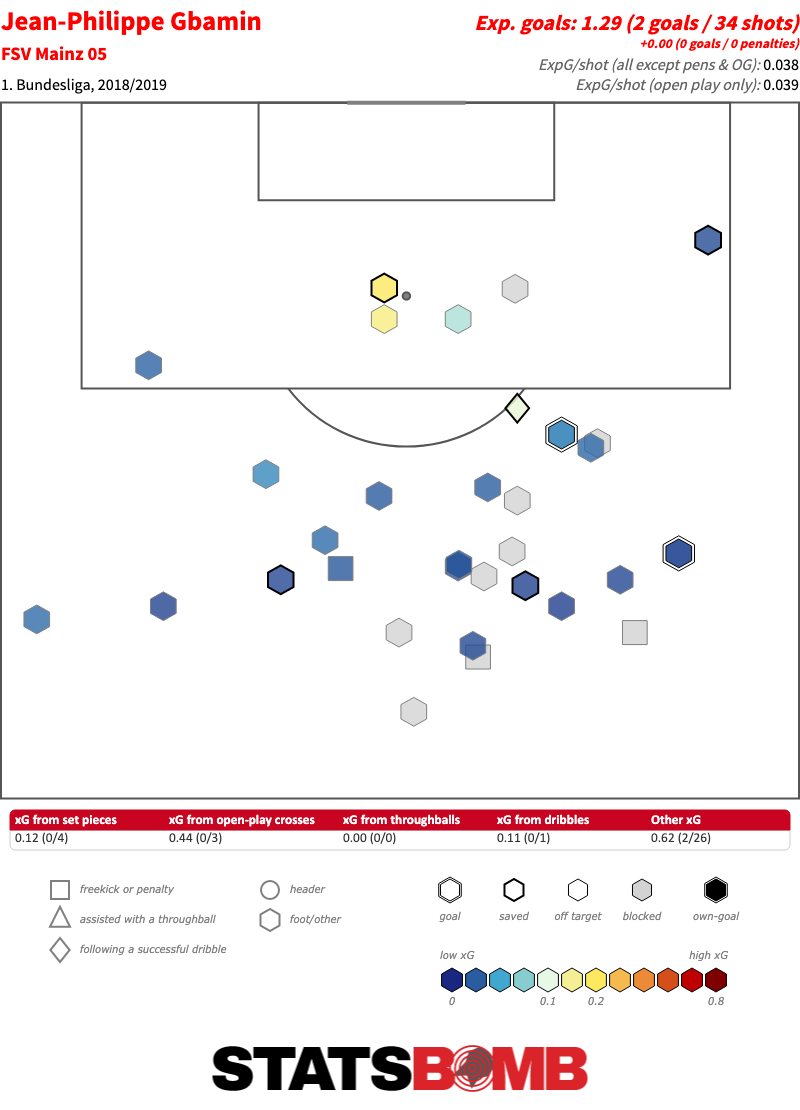 He hasn’t even pulled the trigger yet at Everton… On signing the Ivorian, Silva stated that Gbamin wasn’t a direct replacement for Idrissa Gana Gueye. Yet due to injury and suspension that’s how he’s chosen to play him so far. Can we assume Gbamin was bought so Everton could gradually switch to a three and have Fabian Delph and Gomes in there with him? Personally, I think this would be a forward step to resolving Everton’s attacking issues where Gylfi Sigurðsson either does something wonderful or does nothing at all. An extra Gbamin shaped body in the middle of the park might lead to more control than the team completing just 300 passes against Watford at home. Would this disruption of shape without the Icelander who works so hard to close down opponents at every opportunity ruin Everton’s good defensive numbers? They’re used to playing this system now and The Toffees are grinding out results with it, but will it get Everton where the club need to go? If Silva thinks it is, I was interested to look at what the radars suggest Gbamin and Gomes bring together as a two:
He hasn’t even pulled the trigger yet at Everton… On signing the Ivorian, Silva stated that Gbamin wasn’t a direct replacement for Idrissa Gana Gueye. Yet due to injury and suspension that’s how he’s chosen to play him so far. Can we assume Gbamin was bought so Everton could gradually switch to a three and have Fabian Delph and Gomes in there with him? Personally, I think this would be a forward step to resolving Everton’s attacking issues where Gylfi Sigurðsson either does something wonderful or does nothing at all. An extra Gbamin shaped body in the middle of the park might lead to more control than the team completing just 300 passes against Watford at home. Would this disruption of shape without the Icelander who works so hard to close down opponents at every opportunity ruin Everton’s good defensive numbers? They’re used to playing this system now and The Toffees are grinding out results with it, but will it get Everton where the club need to go? If Silva thinks it is, I was interested to look at what the radars suggest Gbamin and Gomes bring together as a two:  They clearly both bring different things to the team, which is a good, but it just doesn’t look like it’s enough at this point. Stretching play with deep progressions isn’t part of either’s game or seemingly in Silva’s tactical plan. The lovely Statsbomb Tactics IQ dashboard can show us successful passes (red) versus unsuccessful (yellow). Those longer vertical balls just haven’t come off yet for the new boy:
They clearly both bring different things to the team, which is a good, but it just doesn’t look like it’s enough at this point. Stretching play with deep progressions isn’t part of either’s game or seemingly in Silva’s tactical plan. The lovely Statsbomb Tactics IQ dashboard can show us successful passes (red) versus unsuccessful (yellow). Those longer vertical balls just haven’t come off yet for the new boy: 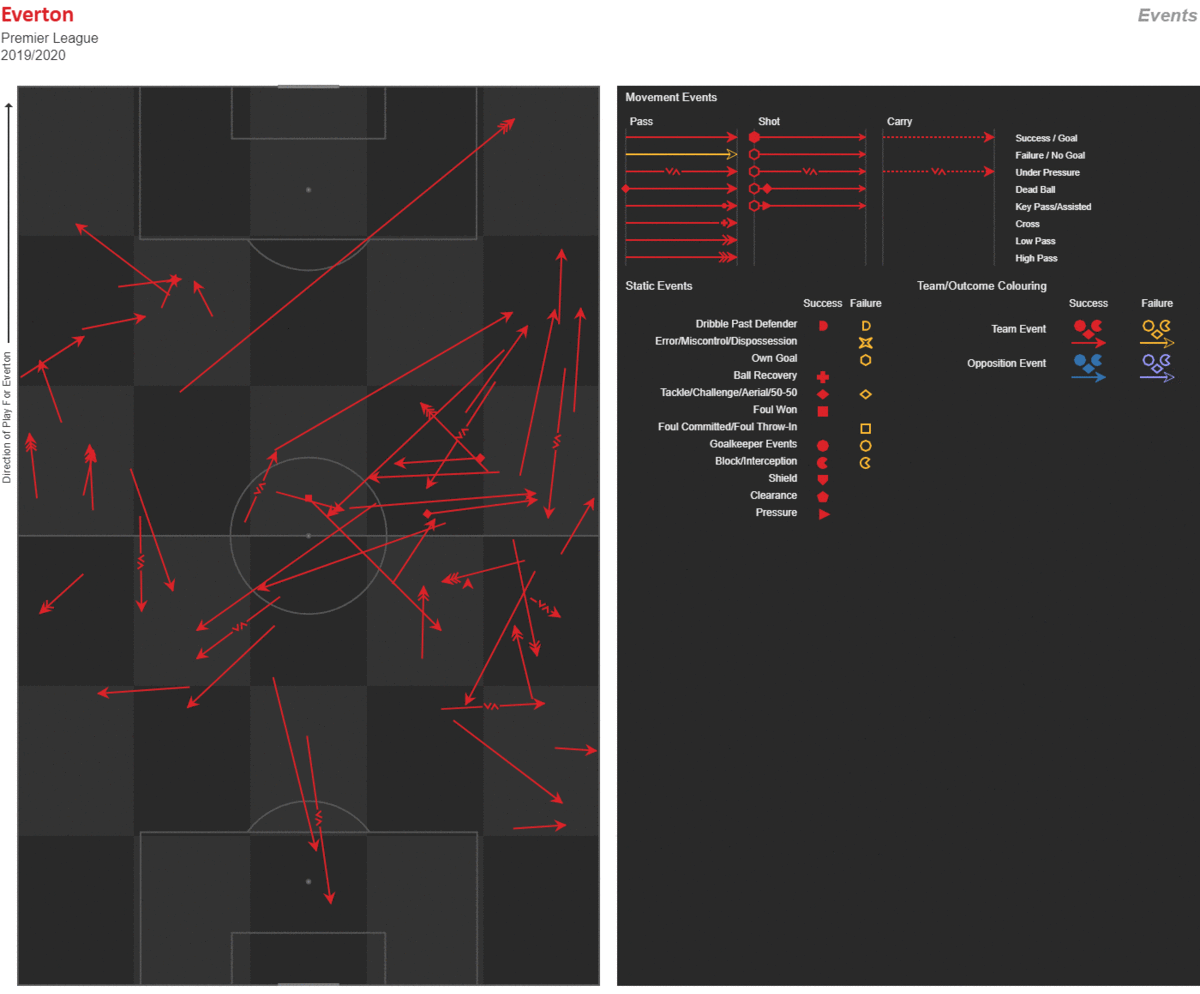 The radar also suggests both are content to sit and hold ground in the middle. The front four do a hell of a lot of the defensive work in front of them. Add in the form of centre back pairing Yerry Mina and Michael Keane and it perhaps explains those good defensive numbers The Blues have right now and showed for most of last season. It’s a safe system. I get the feeling a straitjacket isn’t a look that Gbamin’s particularly keen on. I think he naturally wants to be free. Silva might worry enough to replace him if Delph is back soon from injury. Everton haven’t bought a £25m misfit. He’s just one piece of an expensive jigsaw that isn’t all that easy to put together. The Portuguese may well change it round again for Villa on Friday night.
The radar also suggests both are content to sit and hold ground in the middle. The front four do a hell of a lot of the defensive work in front of them. Add in the form of centre back pairing Yerry Mina and Michael Keane and it perhaps explains those good defensive numbers The Blues have right now and showed for most of last season. It’s a safe system. I get the feeling a straitjacket isn’t a look that Gbamin’s particularly keen on. I think he naturally wants to be free. Silva might worry enough to replace him if Delph is back soon from injury. Everton haven’t bought a £25m misfit. He’s just one piece of an expensive jigsaw that isn’t all that easy to put together. The Portuguese may well change it round again for Villa on Friday night.
Everton: 2019-20 Season Preview
Can Everton distinguish themselves from the rest of the Big Six chasing pack, or will Marco Silva's second season in charge see them plateau or decline as the last two Toffee managers did?
How did Everton look on the numbers last season?
One of my favourite ways to use expected goals these days is by using what I call a ‘Dominance Table’. It’s based on the outcomes of individual matches. ‘What? Using individual game xG values?’ I hear you cry in horror. Yes, my little Statsbombalombas, using individual game xG values! The basic premise is a side has to score full points of xG. They’ve got to do enough to prove that game dominance. It's a nice, down and dirty way to separate out significant instances of bad luck, from the larger ocean of variance.
- 0.78 plays 0.44? That’s 0-0.
- 3.99 plays 0.99? That’s 3-0.
- 2.01 plays 2.77. That’s 2-2.
Everton were absolutely hopeless in the Dominance Table last season until the end of February. Then, something happened. Suddenly, Everton won seven of the last eight games on those xG dominance scores to finish the season with a flourish. A search of my twitter timeline and you’ll see I wasn’t overly enthusiastic about Marco Silva’s appointment last summer. The numbers told me that at both Hull and Watford, he couldn’t get his team to control games to save his life. In game it was a rollercoaster. From game to game it was...also a rollercoaster. With any xG for and against trendline you’ll see at least some volatility, but Silva continues to be The Tycoon: 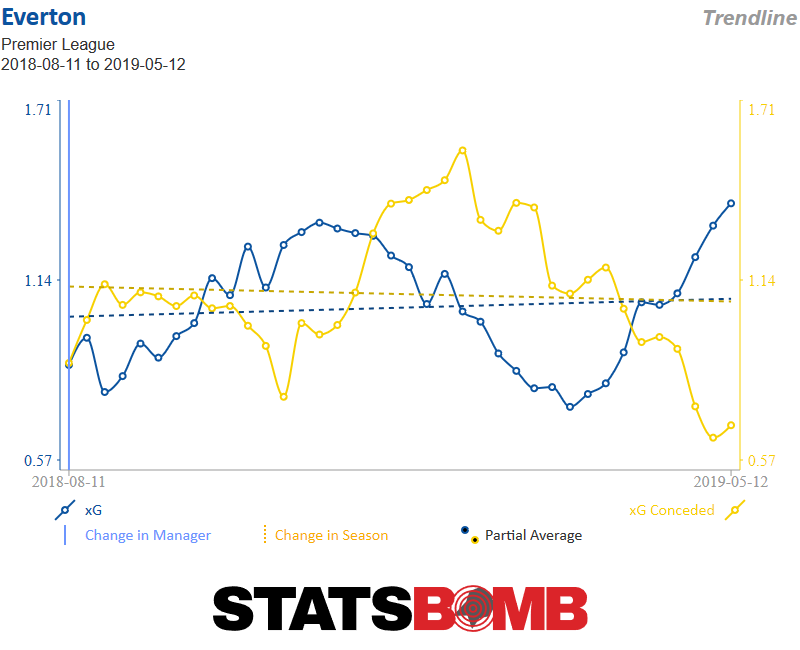 Here’s three tweets I sent in the last 12 months. One from last July, one from December and then one in April. https://twitter.com/footballfactman/status/1022586236597411841 https://twitter.com/footballfactman/status/1069268088267378688 https://twitter.com/footballfactman/status/1120295331957178368 Dominic Calvert-Lewin finally started getting regular starts and game time from March onwards. The team started to improve again in attack. It had sunk back to Sam Allardyce levels previously.
Here’s three tweets I sent in the last 12 months. One from last July, one from December and then one in April. https://twitter.com/footballfactman/status/1022586236597411841 https://twitter.com/footballfactman/status/1069268088267378688 https://twitter.com/footballfactman/status/1120295331957178368 Dominic Calvert-Lewin finally started getting regular starts and game time from March onwards. The team started to improve again in attack. It had sunk back to Sam Allardyce levels previously.
Do Everton desperately need a centre forward?
I’ve heard many Everton fans say Calvert-Lewin can’t finish, that we need someone who is going to score more goals. Everton already have a natural finisher in Cenk Tosun. He just can’t do anything else. Apparently, Everton need a target man who can hold it up, has pace and mobility and can score 20 goals a season on top of that. Well, no kidding. The thing is, Calvert-Lewin is great in the air, can hold it up, has pace and mobility (and a great work ethic) and he can finish. xG? Statsbomb say 10 over the last two seasons. Goals? 10. Maintaining par with xG over time is good. The only youngsters (below 23) in the Premier League shooting enough in open play to get more xG than Calvert-Lewin (mostly with more minutes played too)? Gabriel Jesus, Marcus Rashford and our very own Richarlison. That’s it. But Silva wants a new forward. Wilf Zaha was on on their radar before Everton acquired Italian youngster Moise Kean from Juventus for £29 million. Read my statistical profile of him here. With these type of players, and the recruitment of Richarlison last summer, it would appear Silva wants a fluid front line rather than a central focus.
What does this team need then?
Despite my criticisms of his game management, one thing the numbers make pretty clear is that Silva sorted the team’s defending out on the whole. Forget a bit of early set-piece woe for a minute, Silva’s dragged the defensive numbers back to David Moyes levels according to xG. That is damned impressive for his first 12 months in charge. Peering back into my own, pre-Statsbomb model makes it clear. 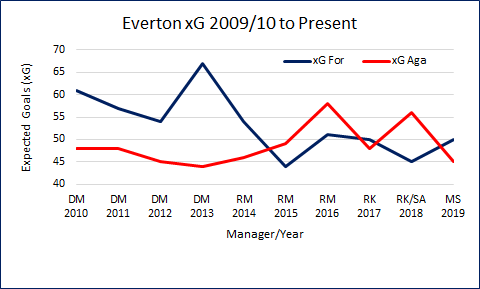 Keeper spots look sorted. Jordan Pickford’s come through his wobble it seems and had a solid season on the numbers again. Everton have added Jonas Lossl (urgh) to deputise with Maarten Stekelenburg (double urgh). Neither have ever looked any good on the numbers but barring an injury to Pickford, it probably doesn’t matter all that much for now. Kurt Zouma had a very successful loan spell last season and ended up playing more than twice as much as Colombian Yerry Mina who Everton brought in permanently after an impressive World Cup. Everton appeared to want him permanently but it looks like Frank Lampard wants Zouma to stick around at Chelsea and Zouma isn’t going to upset that applecart. Mina excelled again for Colombia in this summer’s Copa America. If he doesn’t get more game time this coming season, it would seem something may be up behind the scenes at Goodison for our Yerry. Will Mason Holgate return and deputise at centre back following a pretty successful loan at WBA where he mostly played at right back? Left back looks sorted with Lucas Digne having an impressive debut season, Leighton Baines signing a year’s extension and Fabian Delph now providing even more cover if need be. The right back slot looks a weak link. Seamus Coleman has recovered from a serious leg break but doesn’t consistently look his old self. Youngster Jon-Joe Kenny has gone off to the Bundesliga on loan with Schalke after huffing and puffing but never really looking convincing. Holgate may well provide cover there too. Midfield is where Everton need a damn good revamp With Idrissa Gueye turning 30 this year, I wanted him off in January for the money PSG were willing to pay. Rumour had it that Director of Football (DoF) Marcel Brands wanted that too but Silva dug his heels in to keep the Senegalese. He must’ve been wearing fairly flat shoes, though, as Gueye’s now gone. Fabian Delph? Same age as Gueye, gain money on the transfer fees involved, lose a chunk of it on the wages Delph will command. It strikes me as a fairly pointless exercise as we’ll still be looking for replacements. It doesn’t move the team forward beyond next year. Is Delph going to come to sit more of his waning career out on the bench of a lesser team for less money? You have to assume that if Delph comes, he’s been told he’s first choice or at least getting a bundle of minutes. Is Andre Gomes good enough to challenge the top 6? Even his most ardent fans concede how badly he struggled during the winter months when the team slumped. Let’s look at what last season’s midfield two brought to the table as individuals. Greyed area is league average, blue is our player:
Keeper spots look sorted. Jordan Pickford’s come through his wobble it seems and had a solid season on the numbers again. Everton have added Jonas Lossl (urgh) to deputise with Maarten Stekelenburg (double urgh). Neither have ever looked any good on the numbers but barring an injury to Pickford, it probably doesn’t matter all that much for now. Kurt Zouma had a very successful loan spell last season and ended up playing more than twice as much as Colombian Yerry Mina who Everton brought in permanently after an impressive World Cup. Everton appeared to want him permanently but it looks like Frank Lampard wants Zouma to stick around at Chelsea and Zouma isn’t going to upset that applecart. Mina excelled again for Colombia in this summer’s Copa America. If he doesn’t get more game time this coming season, it would seem something may be up behind the scenes at Goodison for our Yerry. Will Mason Holgate return and deputise at centre back following a pretty successful loan at WBA where he mostly played at right back? Left back looks sorted with Lucas Digne having an impressive debut season, Leighton Baines signing a year’s extension and Fabian Delph now providing even more cover if need be. The right back slot looks a weak link. Seamus Coleman has recovered from a serious leg break but doesn’t consistently look his old self. Youngster Jon-Joe Kenny has gone off to the Bundesliga on loan with Schalke after huffing and puffing but never really looking convincing. Holgate may well provide cover there too. Midfield is where Everton need a damn good revamp With Idrissa Gueye turning 30 this year, I wanted him off in January for the money PSG were willing to pay. Rumour had it that Director of Football (DoF) Marcel Brands wanted that too but Silva dug his heels in to keep the Senegalese. He must’ve been wearing fairly flat shoes, though, as Gueye’s now gone. Fabian Delph? Same age as Gueye, gain money on the transfer fees involved, lose a chunk of it on the wages Delph will command. It strikes me as a fairly pointless exercise as we’ll still be looking for replacements. It doesn’t move the team forward beyond next year. Is Delph going to come to sit more of his waning career out on the bench of a lesser team for less money? You have to assume that if Delph comes, he’s been told he’s first choice or at least getting a bundle of minutes. Is Andre Gomes good enough to challenge the top 6? Even his most ardent fans concede how badly he struggled during the winter months when the team slumped. Let’s look at what last season’s midfield two brought to the table as individuals. Greyed area is league average, blue is our player: 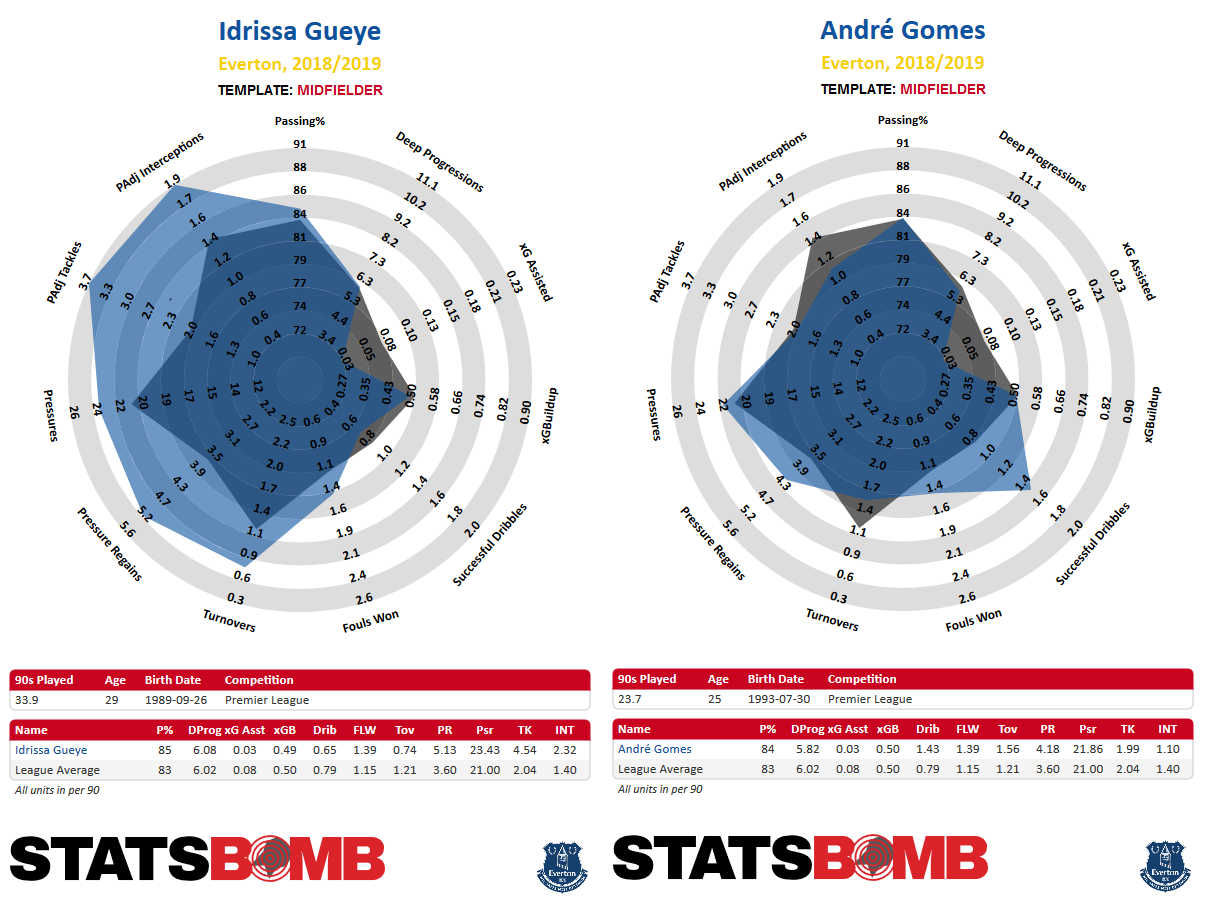 No surprises with Gueye. A pint-sized defensive juggernaut battering about the pitch knocking guys (ahem) half his size about. There’s next to nothing between them on the ball, though. Gomes has the reputation amongst fans of being a cultured ‘baller while Gueye is regularly accused of giving it away every five seconds. The stats don’t back those eye witness accounts up. At all. Gomes has a strong beard game and is pretty much Premier League average at everything. As it stands Gomes and Delph are probably the first-choice midfield two. Delph has been trained in the art of the press by the best in the business at City. But he’s also played mostly at left back for the last two years. Everton still have Morgan Schneiderlin, James McCarthy and Muhammed Besic hanging around like bad smells, don’t forget. Hopefully, at least two will have been deodorised by the end of deadline day. Then there’s Tom Davies. The blond, curly-haired skater boi got less than 1000 minutes playing time in the Premier League last season. Rather than get Delph at the wrong end of his career I’d honestly like to have given Davies a proper chance to actually see if he has what it takes to make the grade. The outcome is still the same at the end of it if he doesn’t – an about average midfield is on the pitch for a year or two and we spend big in central midfield to replace it. Delph is a good player. But it’s more money in the Goodison Park incinerator that we’ll never get a return on. And I’m sick of that fire burning bright since Moyes’ left. Midfield is still a hot mess for me that can’t be rescued with just one, possibly underwhelming, signing like Jean-Phillipe Gbamin. It’s a unit. It needs a full overhaul.
No surprises with Gueye. A pint-sized defensive juggernaut battering about the pitch knocking guys (ahem) half his size about. There’s next to nothing between them on the ball, though. Gomes has the reputation amongst fans of being a cultured ‘baller while Gueye is regularly accused of giving it away every five seconds. The stats don’t back those eye witness accounts up. At all. Gomes has a strong beard game and is pretty much Premier League average at everything. As it stands Gomes and Delph are probably the first-choice midfield two. Delph has been trained in the art of the press by the best in the business at City. But he’s also played mostly at left back for the last two years. Everton still have Morgan Schneiderlin, James McCarthy and Muhammed Besic hanging around like bad smells, don’t forget. Hopefully, at least two will have been deodorised by the end of deadline day. Then there’s Tom Davies. The blond, curly-haired skater boi got less than 1000 minutes playing time in the Premier League last season. Rather than get Delph at the wrong end of his career I’d honestly like to have given Davies a proper chance to actually see if he has what it takes to make the grade. The outcome is still the same at the end of it if he doesn’t – an about average midfield is on the pitch for a year or two and we spend big in central midfield to replace it. Delph is a good player. But it’s more money in the Goodison Park incinerator that we’ll never get a return on. And I’m sick of that fire burning bright since Moyes’ left. Midfield is still a hot mess for me that can’t be rescued with just one, possibly underwhelming, signing like Jean-Phillipe Gbamin. It’s a unit. It needs a full overhaul.
You haven’t mentioned our Icelandic friend?
Gylfi Sigurdsson plays more as a second striker than attacking midfielder or No.10. He still only touches the ball the same amount as the wide forwards and centre forwards. He still doesn’t dictate play. What he does bring to the side off the ball is an enormous penchant for closing down opponents. It’s damn useful and in tandem with fellow attackers Richarlison and Bernard’s work ethic it’s clearly gone a long way to helping keep xG against down. Every time I watch, however, I can’t help but think the sum of this team’s parts would be higher without Sigurdsson. I’d like to see a ‘link’ player, or Everton setting up with a more orthodox central midfield three that can work physically closer together on the pitch. Watch Everton and see how they struggle to build through the middle of the park. See how far away options are. The team still plays a relatively much higher % of longer balls then any of the sides they’re chasing. It ain’t great in possession. The midfield needs a full overhaul (sensing a theme).
I don’t much like the structure off the field either
In Farhad Moshiri’s time at the helm Everton have gone about things entirely backwards - hiring managers and then hiring Directors of Football. First time round was bad enough with Ronald Koeman and then Steve Walsh coming in. But then doing it again straight away going hell for leather for Silva months and months before appointing Brands was just…wow. For me, a DoF runs the show and is the direct link between board and the football side. He should be deciding how the team plays, who the players are to play that way and who the coach is to coach that way. Responsibility. I’ve already talked about friction over Gueye to PSG in January. Whose idea was it to bring Luis Boa Morte in as first team coach? Do we really think that’s Brands? Is Duncan Ferguson, a relative novice, the best man for handing out bibs and cones at training? For a club with a billionaire at the helm, is this really nil satis nisi optimum behind the scenes? The new stadium proposals look the absolute business, but they’ve been put together by an outsider being hired in. Let’s make the football club structure the absolute business too, please. Keith Harris and Jon Woods have gone from the board so that’s a good start. But not so long since, Brands became a member of the board. He may have to decide on whether to sack himself if it doesn’t work out. How’s that conversation supposed to go? Since last summer Everton have made some astute purchases that even I can’t moan about, but the players we’ve been linked with this summer still make me question the relationship between manager and DoF.
Make a prediction for next season, then
7th to 10th. Again. The attack has been strengthened by Kean’s arrival but the team still struggle to create from further back. Thankfully the individual talent is there to get points when they’re not deserved, but some damn cohesion would be nice. I have my doubts we’ll get it but there’ll be some moments of brilliance along the way. Sign a ‘proper’ midfielder that can do everything well and we’ll get nearer to 6th both positionally and points-wise. Sign a younger, rawer version of Gueye, and it’s positive for the medium to long term but perhaps not the short term unless we get really lucky. If Silva does go for that fluid forward line rather than using DCL or Kean as the focal point, with Gueye gone, will the defence be protected enough in front? We may see that xG against creep back up. The earlier deadline day looms large and there’s still so much work to do before Everton can realistically start challenging the big boys. A squad heavy in age and wage makes maneuvering the transfer canvas an awkward, lumbering process. The longer it goes on the more you worry about having to swing a desperate haymaker for a knock-out blow. If it lands then boom, if it doesn’t…well, you’re even more out of shape than ever. I’ve made my own version of Arya Stark’s list that I repeat every night before bedtime. It contains every player at Everton that constantly feeds that money burning incinerator. All of them at the old man end of the age-curve and some of them are even brand (Brands?) new fuel: Leighton Baines, Seamus Coleman, Kevin Mirallas, James McCarthy, Oumar Niasse, Maarten Stekelenburg, Morgan Schneiderlin, Yannick Bolasie, Cuco Martina, Cenk Tosun, Theo Walcott, Gylfi Sigurdsson, Jonas Lossl, Fabian Delph. Lose most of these in the next 12 months and I’ll be predicting a much brighter, much more flexible future. Header image courtesy of the Press Association
How Should England Build Their Team?
What did we learn about England at the World Cup?
First off, the team were heavily reliant on set-pieces to create chances. There was little to no open play creativity. Some were pretty convinced the new set-up was mainly for defensive purposes. I’m convinced otherwise because Steve Holland, Gareth Southgate’s assistant, said this in a great interview with Daniel Taylor at the Guardian:
“The game against Holland in March was the first time you would have seen us play with two offensive ‘No 8s’ rather than a Livermore, for example, who’s a good player but more defence minded,” Holland says. “Nigeria was the first time we tried Dele there – the balance of him running forward, the positions Jesse was taking up and Raheem dropping short. That created problems for our opponent.”
“After [Harry Kane], where are our goals? Dele has goals for Tottenham but hasn’t yet managed to do that consistently [for England]. Raheem has goals [for Manchester City] but hasn’t quite transferred that to international level. Jesse has taken time to get goals for Manchester United. He got into great positions [against Tunisia]. Have we better scoring options in that position? I’m not sure we have. We’re going with the players we think have the potential but they’re young men with not many caps. It might just take a bit of time.”
In that same interview, Holland stated that Southgate knew the start of a qualifying campaign wasn’t the time for revolution.
Arguably, neither is the immediate run up to a World Cup tournament, but hey, they changed it. But the new look is 11 games old now. It’s been tested out for several months both with competitive matches and the rare month-long opportunity to get continuous work in on the training ground in Russia.
So at the start of another qualifying campaign, will Southgate stick, or be brave and twist? Following the tournament the England boss played growth and development bingo in his press dealings. He was talking a good game. I have my doubts he’ll walk it. Throughout his career, Southgate has been Captain Sensible, it’s almost unthinkable that he would change it up now, especially as the media and public are with him.
Perhaps more pertinently, the start of the UEFA League of Nations is upon us. The new tournament provides a potential parachute to those who don’t make it in qualifying proper for Euro 2020 – the groups for which won’t even be drawn until December 2019.
This whole new format is absolutely perfect for making important decisions about team set-up way before any matches of real importance get going. Before 2018 is done, England get to try the current system out 5 more times against good quality opposition in Spain (twice), Switzerland and Croatia (twice). Oh and the USA too.
That would be 17 games in 6 months to get things to gel in attack. If it does, great. If it doesn’t and England still can’t get those chance creation numbers up, there’s some serious evidence there to drop it and still a full year to come up with a new plan for qualifying.
The Current Set-Up
England have produced a "DNA document" that discusses their ideas behind how they want to approach how they play, and it states that:
England teams aim to regain possession intelligently, with a focus on winning the ball as early and as efficiently as possible.
The World Cup centre back trio were Kyle Walker, John Stones, Harry Maguire. None of those guys regularly play in a back 3 for their club. Jordan Pickford does not keep goal with back three in front of him at Everton. Kieran Trippier and Ashley Young have never played regularly as wing backs next to a back three at club level.
By the numbers, the teams who press the ball highest up the pitch the last two seasons are Tottenham, Manchester City and Liverpool.
The teams that actually do as the DNA states don’t employ a back three regularly. Mauricio Pochettino and Pep Guardiola have flirted with one on the occasional trip out, but tend to go back to a four where they know it’s comfortable. Jürgen Klopp rarely strays from his beloved back four.
The Game Strategy “How We Coach” section of the DNA states:
Plan
- Devise a specific tactical plan for each fixture
- Use recommendations and evaluation from previous fixtures and training to inform planning
After each fixture the effectiveness of the game-strategy is reviewed against individual and team objectives. The review process utilises all available data and statistics and is supported by all performance service functions.
To my eyes during the World Cup, there didn’t seem to be much evidence of tailored specific tactical plan for each fixture. England played pretty much the same way against every opponent. And unless the effectiveness review was limited to just looking at the result, the poor attacking numbers in open play available clearly didn’t inform planning to change anything.
As our own Ted Knutson pointed out on Twitter even the set-pieces weren’t changed up. Everything was knocked in to Maguire. Effective? Damn, yes. A specific tactical plan for each fixture? Nope. We flog to death what we can see works right now.
Both Southgate and Holland have shaped the team into what they know themselves: the back three, the attacking full backs. Southgate as player played a huge chunk of his career in this system. Holland in the interview states his time at Chelsea under Antonio Conte influenced his back three thinking.
At the World Cup the back three dominated possession of the ball. All three made around a hundred more passes than anyone else. The only midfielder who made more passes than Pickford was Jordan Henderson.
Guardiola re-inspired football to the extent that people were talking about him playing with ten midfielders if he could. England are effectively trying to play with one. Where is the link up from all those ballers at the back to those runners up the front?
Sorry, but I’d drop golden boy Maguire. I don’t want three at the back and I want more people in midfield. As Pep has been caught saying: “The guy is not fast”.
Stones is just about better all round and more mobile, Walker is super quick, can defend 1 v 1 and mop up Stones’ gaffs (and his own). As a bonus, with no Maguire, it means England have to come up with a new set-piece routine or two before everyone figures out how to stop it.
After Harry Kane, where are our goals?
City don’t play with two offensive ‘No 8s’, a roving forward who also comes into midfield (Sterling) and a bustling centre forward (Kane) who also loves dropping off deep to receive the ball. Nor do Liverpool. Nor do Tottenham. Why? Because it doesn’t make any sense.
Recently, how has the ball transitioned from back to front effectively for England? It hasn't. Which is why they created next to nothing and can’t score goals goals from open play even with all those ‘goals’ in the line up. Coincidentally the ‘transition’ part of the DNA document in the ‘How we play’ section is one of the shortest. There’s more mention of goalkeepers in it than midfielders.
The top clubs playing the pressing game tend to use if not one playmaker, then two, or if none at all, then an entire central midfield at ease with having the ball 60 times a game each. Both their defences AND midfield dominate the ball.
Back to the DNA document:
The game-strategy is a tactical plan based on the availability of players.
Let’s be honest. England don’t have a playmaker like Eriksen, De Bruyne or Silva.
So let’s look at Liverpool as an example. Once Coutinho had gone, they didn’t have a traditional playmaker either. They played Henderson, James Milner and Georginio Wijnaldum. None are world beaters. But with the right coaching all are comfortable in possession, working the ball, feeding the more talented players, and pressing the ball. They got to a Champions League Final and were part of a team in the Premier League who boasted some damn good numbers. England might have had Henderson and Milner already but for the fact the latter retired from international football two years ago. And that's a shame, for though Milner doesn’t fit the age ethos England have going right now, even to a fairly rabid non-fan like me, there is absolutely no denying it – he’s played really well for 18 months.
For me, that means Fabian Delph should come in. He ticks all of the pressing, physicality and ball possession boxes. He also adds some left footed balance to midfield. Can England find someone to do something like Wijnaldum does? If you look at the Dutchman’s passing patterns and volumes, then yes, and he already played for England at the World Cup. Eric Dier!
The groans are audible, people. Shut up for a minute. Does Dier play for a pressing side? Yep. Does he fit the age profile we want right now? Yep. If you don’t like him then there’s a younger model on the numbers and his name his Harry Winks. Does he play for a pressi…you get the idea. But forget Winks, let’s stick with Dier for now.
We’re balancing up the Dier groans with some yays because Young would be gone for me. He is nowhere near a left back that you’d want in a pressing team, who works solidly for 90 mins like, well…Kieran Trippier. Do we have a player who’s played left back for a pressing team, who’s comfortable on the ball, who gets forward? Yes! Two of them were in England’s World Cup Squad! Fabian Delph would fit the bill, but we're using him in midfield so welcome Danny Rose.
That leaves us trying to replicate Liverpool’s front three in some way. First up let's look to the sides, can we find a Sadio Mané and a Mohamed Salah? Wide forwards, great pace, ball carrying skills, ability to get into good areas in the box. Raheem Sterling does that for City. Every week. Does he play for a pressi…you get the idea…
After that we’re struggling a bit for direct replacements in wide positions. Sterling is more like Salah than Mané. So who can match Mané’s pace, intelligent, well-timed runs in wide areas and ability to get in the box for goal scoring opportunities? For me, it’s Jamie Vardy. He hasn’t got Mané’s eye for a pass but he brings everything else to the table. However, Vardy retired from international football so that brings us to Marcus Rashford. He is a lot younger, nicer(!), and is more effective at carrying the ball.
That leaves someone for the Roberto Firmino false nine-ish role. Without much forward dynamism in midfield, the player here has to be mobile. Do we have someone that loves to dart back and forth between midfield and the box? Someone who can create and score goals? Plays for a pressing team? Step forward Dele! Yep, I’ve just dropped Maguire AND Harry Kane.
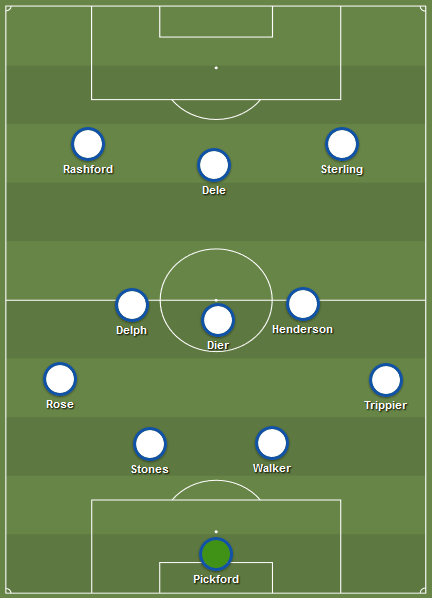
With the likes of Kane coming in you could go for a more orthodox front three. There’s a lot of diverse young forward talent making strides in the Premier League right now to add in too. At the back, Maguire for Stones is not really a problem either. There’s seemingly never been more young English defenders playing regularly at top level than right now. Identifying these contenders is for another article. For now, the shapes all make sense and the players make sense. Well, to me at least.
Can England become a genuinely good team with sustainable ideas that fit their published ethos? For me, there are loads of options to make numerous variations of 4-3-3 work where England should be able to join it all up more effectively - dominate possession of the ball in BOTH the first two thirds AND press effectively from the middle third onwards – all the while posting good underlying numbers at both ends of the field.
Jack Butland - Christmas No.1
I first set eyes on Jack when he was a lad at the 2012 Olympics. He was 19, a mixture of good and terrible, of confidence and over-exuberance. Three years on, and Butland is finally a first choice Premier League goalkeeper. He's had a great start: conceding less than a goal a game and keeping 7 clean sheets in the process. Stoke sit comfortably in 11th position right now. I reckon The Potters would be right in the relegation mix without his contribution and my xG model says he's prevented 5-6 goals more than expected for the shots he's faced. Many fanalysts have written off keeping metrics as 'voodoo' because data-wise, there's no repeatability in performance from one year to the next. Well, that's not a reason to dismiss it and leave it there, that's a reason to go and find the reasons why. Lack of anticipation of the shot is huge. There are tons of tiny technical goalkeeping details that are barely noticeable in real time. You have to slow the game footage right down and watch it again and again. Whether it's mis-timing the take-off bounce when trying to increase diving power, or a small step the wrong way just before the shot comes in, getting set properly matters. I correspond with a Polish goalkeeping coach that has worked with his national side. He talks about crouching at the right moments. He talks about teaching better anticipation. He talks about reading of attacker/defender dyads and measuring movement patterns in training with strategically based cameras. Remember Carragher and Neville pulling Tim Howard and Simon Mignolet apart? Watch it again. Even if you disagree with some of the points made, it's the best piece of football analysis and discussion there's been on TV in a long time. Butland's performances this season have been an absolute lesson in all of those technical details. Below is a graphic of all the shots on target he's faced this season (yellow dots are goals). I've highlighted the danger zone SoTs. Currently, Butland's save % here is at 85% - 20% higher than any keeper's ever finished the season with: 
EPL 2014-15 Season Preview - Everton
What's new? At £4m, Muhamed Besic comes in as a low-budget, high-potential signing to 'bolster' midfield and defence. Flying wide-forward Gerard Deulofeu returns to Barcelona to be replaced by another loan - Chelsea's Christian Atsu who played at Vitesse last year. Moves for last year's loanees Gareth Barry and Romelu Lukaku have been made permanent. Everton has splurged about £30m (the majority of the budget) to keep hold of players already embedded in the side. How did Everton line up last season? The graphic below shows the main first XI and passing networks. The bigger the circle, the more touches the player had. The thicker the arrows, the more passes in that direction. For scale purposes, it's all per 90 mins: 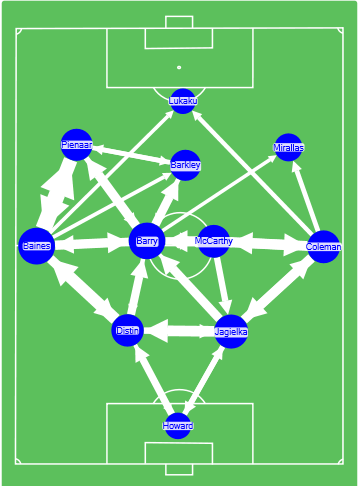 It's pretty clear how Barry became the hub of the side last season and why Martinez sought to make the move permanent. The player wasn't short of offers it seems, which is presumably why Everton had to suck up a 3-year deal to secure the 33 year-old. The build up is much shorter these days. Howard is as likely to distribute to the centre backs as he is to lump it. McCarthy is the continuity man, content to knock the ball sideways to Barry and Coleman who work the ball forward. Also apparent is that the left hand side is still pretty huge. Where the left side is often intricate, the right hand side is more crash-bang-wallop with moves often ending at the feet of Barkley and Mirallas. Watching games last season you'd often see Lukaku's frustration at these two (especially Barkley) failing to spot runs and going it alone. More on this later. Will the line-up change with the new boys? It'll likely be as you were to begin with. But with League Cup games and Europa fixtures to negotiate in the early months both new boys will be featuring if fit. Martinez was very comfortable rotating players in and out last season. What with injuries, suspensions and loan restrictions none of the midfield or forwards were overworked minutes-wise. I can see the burden being shared around again. People were worried that the defence wouldn't hold under Martinez. How wrong were they? Yep, only a goal a game conceded was in line with the previous few years. However, here at Statsbomb we're dedicated (ching) to bringing you the underlying numbers that are more meaningful in the long term. The graphic below shows the the increase in total shots conceded and Expected Goals Against last season. This is almost always bad news:
It's pretty clear how Barry became the hub of the side last season and why Martinez sought to make the move permanent. The player wasn't short of offers it seems, which is presumably why Everton had to suck up a 3-year deal to secure the 33 year-old. The build up is much shorter these days. Howard is as likely to distribute to the centre backs as he is to lump it. McCarthy is the continuity man, content to knock the ball sideways to Barry and Coleman who work the ball forward. Also apparent is that the left hand side is still pretty huge. Where the left side is often intricate, the right hand side is more crash-bang-wallop with moves often ending at the feet of Barkley and Mirallas. Watching games last season you'd often see Lukaku's frustration at these two (especially Barkley) failing to spot runs and going it alone. More on this later. Will the line-up change with the new boys? It'll likely be as you were to begin with. But with League Cup games and Europa fixtures to negotiate in the early months both new boys will be featuring if fit. Martinez was very comfortable rotating players in and out last season. What with injuries, suspensions and loan restrictions none of the midfield or forwards were overworked minutes-wise. I can see the burden being shared around again. People were worried that the defence wouldn't hold under Martinez. How wrong were they? Yep, only a goal a game conceded was in line with the previous few years. However, here at Statsbomb we're dedicated (ching) to bringing you the underlying numbers that are more meaningful in the long term. The graphic below shows the the increase in total shots conceded and Expected Goals Against last season. This is almost always bad news: 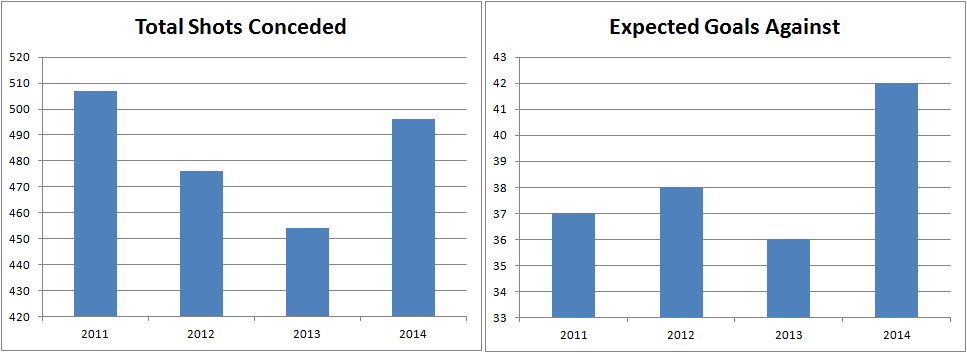 Thanks to the work of Colin Trainor and Constantinos Chappas, we're able to compare defensive actions visually. What we saw under Moyes was a super-concentrated effort to defend central 'prime' areas. Content with a draw or a 1-goal lead Everton would often shell defensively in order to see the game out. It was uncomfortable edge of the seat stuff.
Thanks to the work of Colin Trainor and Constantinos Chappas, we're able to compare defensive actions visually. What we saw under Moyes was a super-concentrated effort to defend central 'prime' areas. Content with a draw or a 1-goal lead Everton would often shell defensively in order to see the game out. It was uncomfortable edge of the seat stuff. 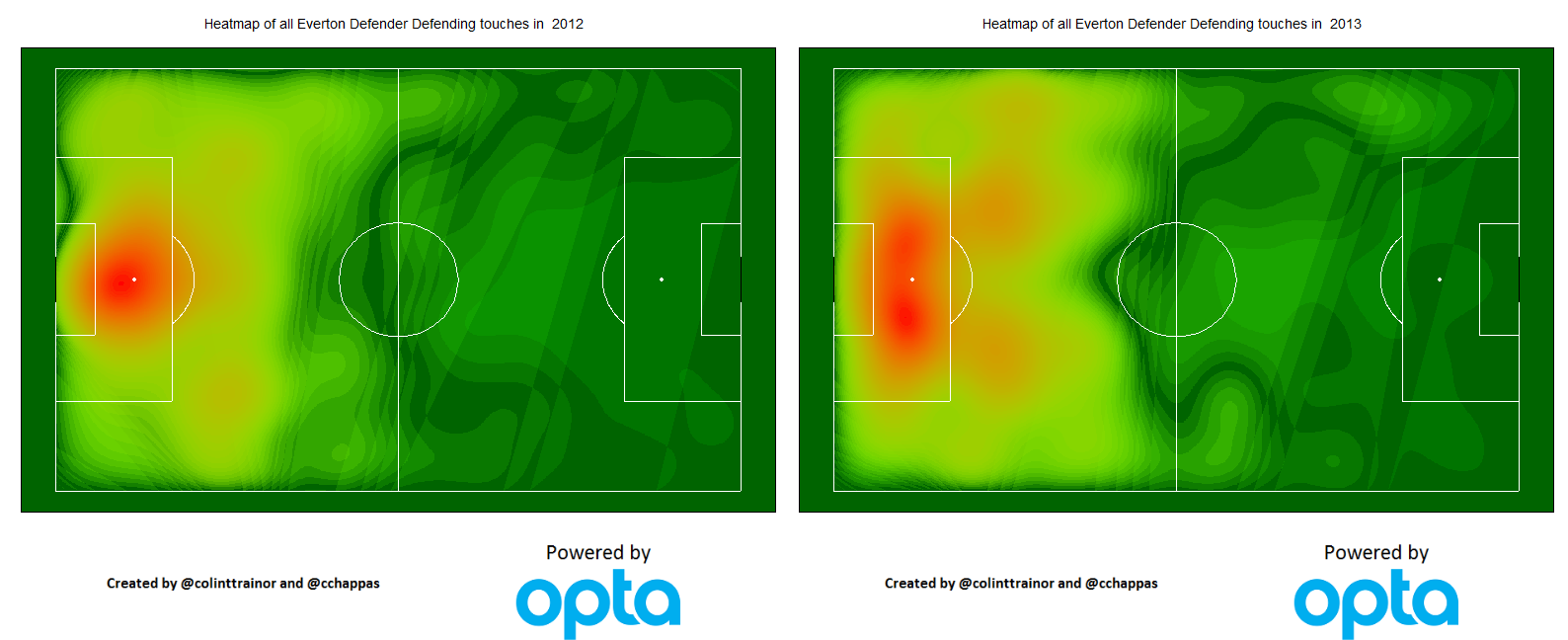
That hasn't been the case under Martinez. There was a willingness to go toe to toe at the end of games last season using the likes of Mirallas, Barkley and Deulofeu to counter. It was a lot easier to watch. As we've seen , the underlying numbers suffered for this more open style. I've written previously about Tim Howard's huge performance last season. Unfortunately for the Blues, history shows that such over-performance isn't sustainable. Howard was undeniably good last season, but luck also played a huge factor. His save% from the prime Zone 1 area was 57%. League average is 44% - a keeper has more chance of callling heads or tails on a coin toss than saving a shot from here. Basically, the numbers suggest it's far more likely that more of the same next season will result in nearer 50 goals conceded than 40. Unless the shot count goes down, expect Everton to get stung a little more often.
What about the attack?
Lukaku is a huge signing. The indications are that he's on an upward slope. However, with Kone still yet to play a game since his knee injury in November, the only contingency at present is Steven Naismith. Naismith's brain makes up for a lack of footballing aestheticism. His movement and finishing is good. I really like him, but he's not up to being a starter for any length of time if Everton have serious pretensions of kicking on. That said, if I was in charge he'd be getting good minutes as a substitute on an almost weekly basis.
Everton's other problem is what to do with Mirallas and Barkley. Both are super talented, but neither has the final output that marks them out as super special. A goal tally of 14 goals between them last season just doesn't seem enough.
I read somewhere that at the press conference announcing Barkley's new contract, the youngster stated he wanted to play more games in central midfield. Martinez apparently raised his eyes skyward. The kid might actually have a point. Here's Barkley's shot chart for last season. Yellow dots are goals, blue dots were saved, black dots were off target:
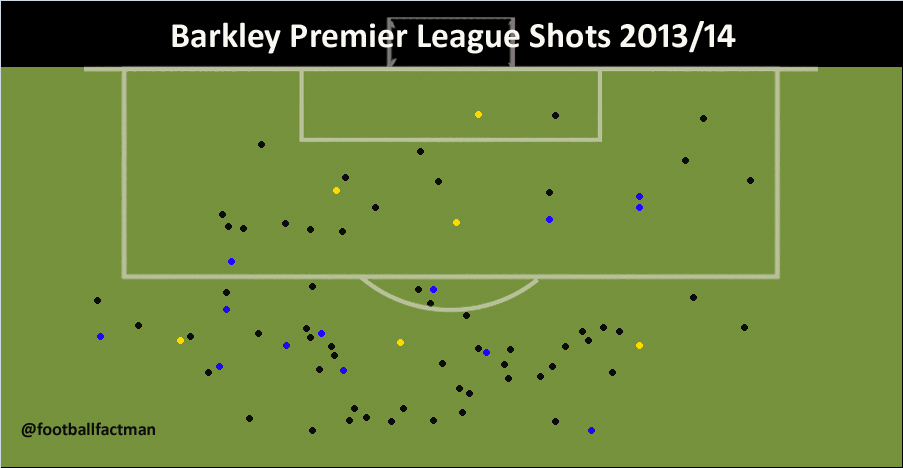 His shot on target rate was fairly abysmal. Too often for Barkley, shooting is a last resort when he's off balance, out of ideas and the chance to play a team-mate in has gone. On top of this, he is still yet to record a Premier League assist. For someone in 'the hole', this simply isn't good enough. The problem is that every now and then he goes and does something so ridiculously good (Swansea, Newcastle, Man City) that a lot gets forgiven and forgotten. Martinez needs to work out the pay-off between allowing time for potential to develop and pushing the team on results-wise. The shooting story for Mirallas is a similar one. The Belgian blazes away with a scatter gun approach. Nominally stationed on the right, Kev's best creative work is done out there. But being on that side creates problems with shooting angles for a right footed player:
His shot on target rate was fairly abysmal. Too often for Barkley, shooting is a last resort when he's off balance, out of ideas and the chance to play a team-mate in has gone. On top of this, he is still yet to record a Premier League assist. For someone in 'the hole', this simply isn't good enough. The problem is that every now and then he goes and does something so ridiculously good (Swansea, Newcastle, Man City) that a lot gets forgiven and forgotten. Martinez needs to work out the pay-off between allowing time for potential to develop and pushing the team on results-wise. The shooting story for Mirallas is a similar one. The Belgian blazes away with a scatter gun approach. Nominally stationed on the right, Kev's best creative work is done out there. But being on that side creates problems with shooting angles for a right footed player: 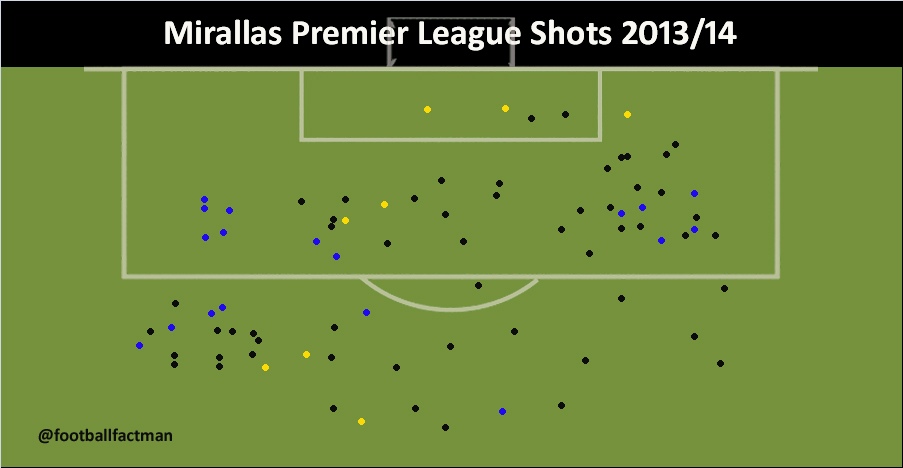 At Olympiakos he scored bags of goals while mostly stationed out left or through the middle. Everton still haven't found Mirallas' best fit. He'll flit left or sometimes go through the middle to varying success. I like the signing of Atsu. He profiles a lot like Deulofeu. He can beat players, and likes to take a shot but unlike the boy from Barcelona, he also has the ability to look up from his boots every now and again. Note the higher pass completion rate and key pass numbers:
At Olympiakos he scored bags of goals while mostly stationed out left or through the middle. Everton still haven't found Mirallas' best fit. He'll flit left or sometimes go through the middle to varying success. I like the signing of Atsu. He profiles a lot like Deulofeu. He can beat players, and likes to take a shot but unlike the boy from Barcelona, he also has the ability to look up from his boots every now and again. Note the higher pass completion rate and key pass numbers: 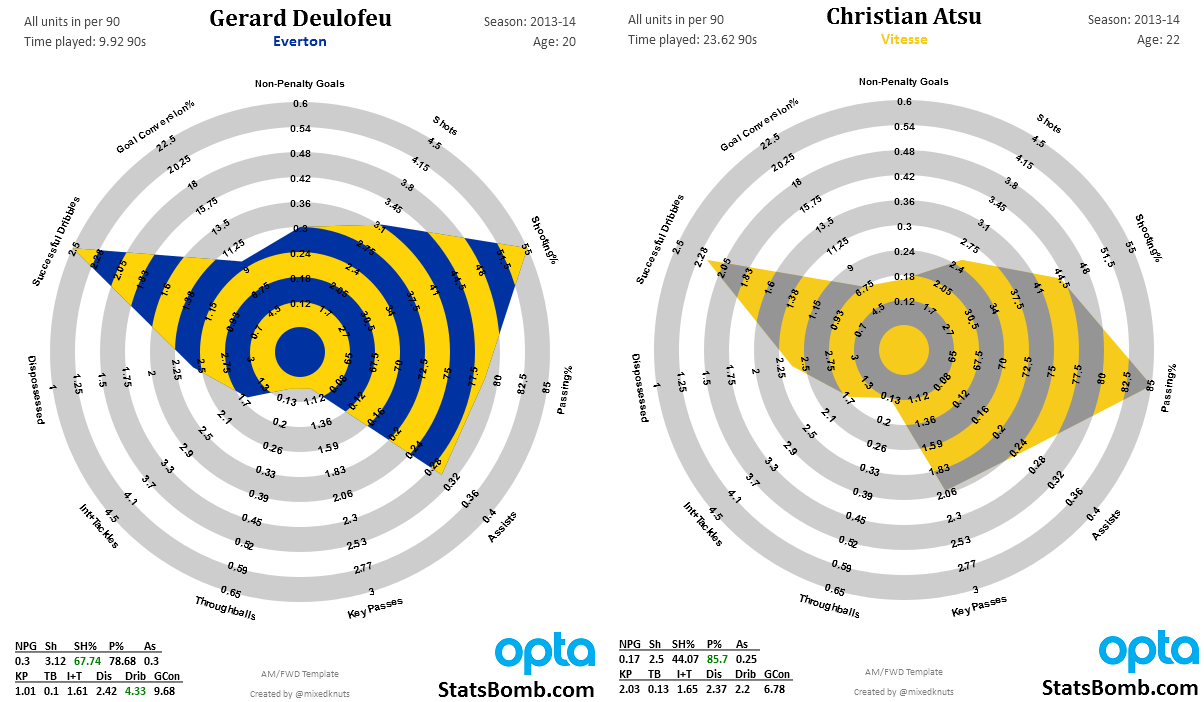 Conclusion? Unless Everton stem the tide of shots then defence is going to get worse. Factor in the ageing of Jagielka and Distin who rely so much on mobility to do their thang, then look at the possible replacements. Alcaraz isn't mobile, is the wrong side of 30 and is rarely fit. Stones, generally excellent on the ball doesn't look like he can defend well enough yet at this level. Let's cross our fingers and hope for a Coleman-style overnight transformation on that score. Barry is 33. Is he going to be able to get around the pitch to the same effect? Besic is beautiful on the ball and loves getting a challenge in but looking at him here, he's suspect positionally. McCarthy has got a lot of defensive work on this season unless Gibson can get his arse off the treatment table for a spell. Positively, I do expect the attack to pick up the defensive slack but that would rely heavily on Lukaku staying healthy. Getting Kone back ASAP would be a major bonus, especially if he can retain mobility following this his second major knee injury. Don't rule out a move for a striker on deadline day, though. Prediction? 5th-7th again. Probably 6th.
Conclusion? Unless Everton stem the tide of shots then defence is going to get worse. Factor in the ageing of Jagielka and Distin who rely so much on mobility to do their thang, then look at the possible replacements. Alcaraz isn't mobile, is the wrong side of 30 and is rarely fit. Stones, generally excellent on the ball doesn't look like he can defend well enough yet at this level. Let's cross our fingers and hope for a Coleman-style overnight transformation on that score. Barry is 33. Is he going to be able to get around the pitch to the same effect? Besic is beautiful on the ball and loves getting a challenge in but looking at him here, he's suspect positionally. McCarthy has got a lot of defensive work on this season unless Gibson can get his arse off the treatment table for a spell. Positively, I do expect the attack to pick up the defensive slack but that would rely heavily on Lukaku staying healthy. Getting Kone back ASAP would be a major bonus, especially if he can retain mobility following this his second major knee injury. Don't rule out a move for a striker on deadline day, though. Prediction? 5th-7th again. Probably 6th.
The Spanish Inquisition - Roberto Soldado
Once the last ball of the season has been kicked and a few hundred Premier League footballers have flown off to exotic locations to rest their battered feet, I'd like to think club staff get themselves round the table for a season debrief. They'd discuss what went right, want went wrong and what went........Mmmkay. Come May, this process might take a little while longer at Spurs than it would at other clubs. The league position isn't a disaster by any stretch, but player trades on the whole haven't worked out. Sooner or later, the guys at the table (after a long time sidestepping it) would stumble upon what was maybe the crowning turd in the transfer water-pipe. Before the season started, Colin Trainor, voiced concern about the transfer of Roberto Soldado here. Taking penalties away, Soldado has scored 2 league goals this season compared to 19 last. I'm going to try and build on Colin's work by asking the kind of simple questions I'd be asking if I was sat down at that table, discussing the reasons why its all gone paella-shaped. Is Soldado taking less shots? This season he's taking 2.7 shots per 90 mins. Last season he was taking 3.1 shots per 90 mins. That's an extra 15 shots per season if all minutes were played out. He's taken 52 shots this season compared to 100 last. None of this explains the huge difference in goals we've seen. How many shots is he getting on target? Is he getting into the same areas to take them? It's nice to visualise this one. The deeper the red on the graphic below, the bigger the volume of shots on target from that zone:
The graphic quite clearly demonstrates part of the problem. Same areas, but a drastic reduction in volume. Soldado is a penalty box striker, pure and simple.
So how did Valencia 2012/13 compare to Spurs 2012/13? Was it a complete style mismatch when they bought him?
The graphic below shows the volume and type of chance the two sides made in the penalty area last season.
I didn't see much of Valencia last season. I'm not sure what I was expecting to find but it wasn't this. The two teams were almost identical in this regard.
Ok, so what about Valencia 2012/13 versus Spurs 2013/14? Have Spurs done something different?
Once again Spurs are well on track to at least equal Valencia in every department bar set piece deliveries.
So if he's getting in a similar amount of shots per 90 as he was before, he's just not putting them on target as much, right?
Right. Roberto's gone from getting 43% of his open play shots on target last season, to just 23% this season. It's a whopping drop but it's fairly common as you can see in this cracking piece by @willtgm. Will's work suggests that this drop is nearly as likely to be luck or other factors influencing play as much as it's down to the skill of the individual involved.
Those other factors. The teams as a whole might have been similar in style and volume, but maybe Soldado himself isn't getting on to the same type of chance as last season?
This is what that looks like:
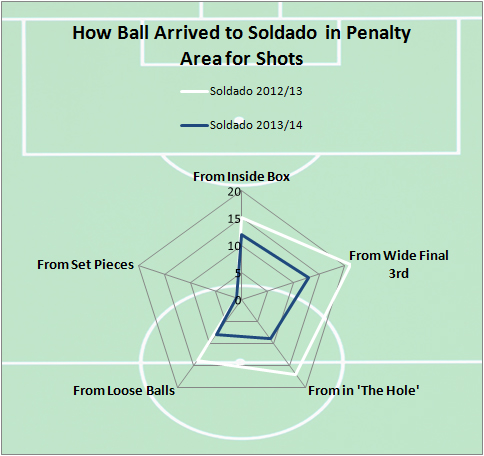 This is pretty much bang on identical too if you take minutes played into account. There's a small drop of passes played into him from in the hole. However, as he didn't score from any of these last season, it's difficult to say it's a problem. The only thing is, this is how both his open play goals for Spurs have come about. Does it take less shots on average to score in La Liga? It does, but the differences aren't significant. Definitely not significant to explain the Soldado puzzle. Might that say something about defensive pressure on the ball? It might, but the data for this isn't publicly available. The video of Soldado's goals is here: http://www.youtube.com/watch?v=Xj-XhTAmvag Looks like a mix here. On some occasions there's time and space to finish and on some occasions it's a tight spot with good movement and finishing on show. The way Spurs played under AVB (high press, hemming opponents in their half) might look a little different to this. Spurs didn't build quickly and as a consequence opposition defences were fairly set. However, under Tim Sherwood things are different and it still hasn't happened for Soldado.
This is pretty much bang on identical too if you take minutes played into account. There's a small drop of passes played into him from in the hole. However, as he didn't score from any of these last season, it's difficult to say it's a problem. The only thing is, this is how both his open play goals for Spurs have come about. Does it take less shots on average to score in La Liga? It does, but the differences aren't significant. Definitely not significant to explain the Soldado puzzle. Might that say something about defensive pressure on the ball? It might, but the data for this isn't publicly available. The video of Soldado's goals is here: http://www.youtube.com/watch?v=Xj-XhTAmvag Looks like a mix here. On some occasions there's time and space to finish and on some occasions it's a tight spot with good movement and finishing on show. The way Spurs played under AVB (high press, hemming opponents in their half) might look a little different to this. Spurs didn't build quickly and as a consequence opposition defences were fairly set. However, under Tim Sherwood things are different and it still hasn't happened for Soldado.
How would the average shooter in the Premier League do with the same volume and type of chances that Soldado's had this season?
My expected goals model suggests 4 goals should have been scored in open play with the shots on target he's had. That would be the benchmark. The Spaniard is therefore only 2 goals behind where he should be. Simulating these shot situations thousands of times over means we can put a measure on how good or bad that performance might actually be.
We can expect a Soldado-esque performance just over 10% of the time. Considering there's only a 20% chance you'll actually get the benchmark performance of 4 goals, Soldado's efforts might not sound so bad. However, the reality is we're looking at an 83% probability that your benchmark shooter would outperform him.
None of this is really explaining it. Has he just been unlucky?
I'll be honest. it's not a term I like very much. When it comes to what happens in football, everyone has a reason for everything. However, when it comes to goalscoring, the longer I delve into the numbers the less reason I'm finding for stuff that happens. My studies into goalscoring so far suggest that even the 'best' strikers in the Premier League come back to mean over time. Is this simply what Soldado is doing? Here's his rolling performance starting from his last season with Valencia until now (this is far back as the publicly available data goes):
Looks like a case of him regressing back to where he should be to me. Will's work on shots on target (linked above) is fairly important. Next season Soldado might just start getting shots on target again and probably getting goals. The staff at the club could no doubt start watching hours and hours of footage and maybe put their finger on the reasons why. I'm sure something could be found and they'd be happy with the explanation. Increasingly, my explanations around goal scoring sound a lot like: sometimes shit happens.
Some nice analytics could probably tip the odds slightly in your favour over time. You should stop looking for certainties - they don't exist. No one wants to hear that message. But if someone like me can get to grips with it, so can you.
Stoke City's New Look - the Long and Short of it
Stoke assistant manager Mark Bowen was doing the rounds last week telling BBC Sport: "We've done passing drills on the training ground and small games to encourage the players to stay on the ball that little bit longer." Even before the season began Bowen was keen to make it known Stoke were going for a style change telling Sky Sports News: "We want the players to know they can play the ball, that mistakes will be made, but that we won't come down on them like a ton of bricks every time." The usual statistics certainly support the fact that Stoke have indeed changed their approach. Whoscored tells us Stoke's possession is up over 6% so that they're now basically sharing the ball 50-50 with opponents. Pass accuracy is up nearly 10%, they've played an average of 100 MORE short passes per game than last year and 9 long balls less. And all this having played Liverpool, Man City and Arsenal already. I though there was a pretty good chance that a lot of this passing might be guff. Lots of sideways passing between centre halves, lot's of middle third possession not actually hurting the opposition. I'll be honest, I haven't seen more than a minute of Stoke's games this season. I'm not sure if I've even seen all their goals yet. What i'm trying to say here is that I simply don't know. What I wanted to do, and what I have done then, is to take a look at the types of chances Stoke created last season and compare them to the types of chances they've created this. On a spreadsheet. Still here? Good. For your viewing pleasure I have translated it all into some easily understood (hopefully) graphics.
For future reference, the 'wheat' zone is the central area inside the box where the vast majority of goals are scored from. See here for further reading. Going on these images it seems the types/number of chance Stoke have created in the wheat zone this season are almost identical to last season's. They've just increased the number of shots they've taken from the 'chaff' areas outside the box. However, when we take into account the opposition played so far, Stoke's passing where it matters HAS improved. My chance creation model enables an expected goals figure to be calculated based on type and number of chances made. In the exact same fixtures last season (substitute Reading for Palace in the newly promoted bottom of the table team stakes) Stoke could have expected to score 3.6 goals in the 6 games. This season they could have expected to score just over 7 goals. For now it doesn't matter that Stoke have only actually converted 4 of these chances. If they carry on creating these chances, they could well see a steady improvement on last year. Follow me on Twitter here.
A Way to Assess One Season in the Bigs
Most football fans on these shores weren’t aware of Michu’s pedigree when he pitched up at Swansea. There was good reason. He barely had one. Even Sir Alex Ferguson stated: “2m and I’d never really heard of him. I should have a word with my scouting department.” This is the same man, however, that said Charlie Adam corners alone were worth 10m, before he passed and let Liverpool take that hit.
I’ll be honest, I don’t watch Spanish football myself, save the glimpses of it I see at Champions League or national team level. I’m one of those who hadn’t heard of Michu or seen him play either.
It would be nice to believe that Michael Laudrup did his homework thoroughly when he bought the Spaniard to Swansea City. Then you look at the 6m he’s just spent on Jonjo Shelvey and think maybe they DO just put a blindfold on and try to pin a tail on the donkey.
At the age of 25, Michu had mostly picked up lower league experience. His scoring record at the club he was about to leave, Celta, was decidedly average. That all changed when he made it to the bigs and joined Rayo Vallecano, a team that had just been promoted to the top flight. Michu suddenly scored 15 league goals - a tally he hadn’t reached in the lower leagues with Celta in over a 100 appearances. Was it a fluke? 18 Premier League goals the following year now suggests not.
Let’s switch our attention to someone else who had his first full season in the big leagues and did well: Christian Benteke. The Belgian was being touted around for £25m last week until he signed a new deal with Aston Villa. The prospective buyers were British, they had a load of cash on the hip, but most of all they’d all seen him play with their own eyes. This matters in traditional scouting. A lot. And so it should, but there’s no way it justifies an extra 20m odd on a player’s price. Traditional scouting should be one part of the jigsaw. A player's underlying numbers should be part of the jigsaw too. But you have to look at the right numbers unless you want to be the next Damien Commoli.
Concentrating purely on predicting future goal tally, it’s important to strip the wheat from the chaff. Wheat is a goal scored from the central area inside the box – a goal that is repeatable. Chaff is the rest – goals from wide areas in the box, goals from outside the box – the kind of goals that only a select few are able to repeat. When you only have one season of big league data, it’s unwise to gamble just yet that your man is able to repeat goals from the chaff.
Stripping out the penalties and chaff, and purely concentrating on the wheat, Benteke is down to 11 league goals for last season. ALL of Michu’s 15 league goals at Rayo were wheat. Well over 70% of Michu’s shots were from wheat areas. Benteke on the other hand was shooting from much deeper in the chaff.
Even the fact that Michu was transferring from Spain to England wasn’t too much of a gamble as Ted Knutson has discussed here on this very site. Michu continued his shooting patterns in the Premier League. Well over 70% of shots taken in wheat areas, 17 of 18 goals scored from there too. Just two seasons in to the bigs and he’s become way more predictable.
Benteke is currently a problem. 8 of 19 goals are chaff or penalties at this stage. If someone really was willing to fork out 25m this summer Villa should have bitten hands off. Even if he repeats his goal scoring feats next season, his value isn’t going to increase in line with them – we might be talking around 30m tops. If his form takes a nosedive next year, we’re probably looking at the 15m mark.
To compare, I was poking around the numbers trying to find a La Liga prospect I’ve not heard mentioned before or indeed seen play. I found Tomer Hemed - a 26 year old Israeli international who plays for Mallorca. His wheat numbers last year were almost identical to Benteke’s. Hemed scored 10 goals in 64 shots from wheat areas, Benteke 11 from 63. What’s more, this was his second season in the bigs. He’d scored 8 goals in 29 appearances (11 as sub) in his first. Half of those were penalties so need to be stripped out. That left 4 goals from 32 shots in wheat areas. That was a below average return first time round, but this guy has improved with playing time, even as the team took a hit and got relegated last year.
So now he’s at a Benteke level of finishing with two seasons of top flight experience under his belt. Here’s the thing. Both are no better than average at finishing where it matters. One is seen as a legitimate target for big clubs at big prices. The other may be bumming around 2nd tier Spanish next season.
This brings us nicely onto new Liverpool signing Iago Aspas. He scored one more goal than Hemed did in La Liga last year. I looked at the youtube reel for both. A couple of minutes was enough to see why Liverpool opted for Aspas rather than the Israeli. The Israeli looks like a typical British centre forward. A bustling type with a bullet header on him. Aspas looks tricky and quick – much more in keeping with the new “philosophy” over at Anfield.
Last year was Aspas’ first in the bigs too. He scored 12 goals in all, but taking out penalties and chaff he’s left with just 5 goals in the wheat at the same below-average conversion rate that Hemed chalked up in his first bit-part season for Mallorca. If Liverpool fans are expecting goal haulage from Aspas, they may be disappointed. He looks like a wide forward who stays wide - only a third of his shots are from wheat areas. The one thing that may make him able to repeat his goals from wide areas of the box is his pace. Getting that extra yard of room seems to be important for those who can repeat getting goals from here. But you still have to be able to control the finish and few are able to.
Getting a controlling handle of your striker transfers needn’t be as cereally (ahem) difficult as football clubs seem to find it year after year. To conclude, I’d be surprised if Michu didn’t comfortably reach double figures again next year, and I’d be surprised if Benteke matches his previous tally. Someone needs to take a small gamble on Hemed who’s out of contract at the end of next season, and Liverpool better hope Aspas lays on some goals to make up for the fact he’ll probably not reach double figures in the goals column.
